Traveller by mllaneza
Introduction
Original SA post
Having read both LF updates and had a quick hugfest on #bwf I'm ready to change the tone completely.

Traveller pt. 1
Let's talk about Traveller !
A few Traveller discussions have popped up in TG recently, so let's put some details out there for the vast majority that don't know all that much about the game and its settings. Most people know the basics; it came out in the late 70s in little black books and featured PCs running around on the fringes of a vast interstellar empire.
That's it in a nutshell. Traveller went through a few iterations, a couple of licensed editions with different systems and three primary official settings. First they set up a big empire, then they shook it up with a civil war, and finally just broke the whole setting and rebooted it in a teradeath collapse. Along the way they produced a wealth of highly technical vehicle, starship and solar system design systems. Prior to GURPS Vehicles, Traveller was the home of the gearhead. I certainly learned most of my spreadsheet skills by automating design sequences.
The two most notable things about Traveller are the Imperium and character creation. I will examine both of these in this post, then in later posts get into the mechanics, settings, rule editions, third party support, and staggering amounts of neat stuff in more detail. This could take a while.
Characters
The most unique mechanic they came up with was the Universal Personality Profile (there were also Planetary and Ship profiles). A UPP was the six ability scores in order. To allow for double-digit scores, hexadecimal notation is used, e.g.10=A, 15=F. Add a name, rank, title and skills and you have a very compact statblock. Let's roll up a Book 1 character real quick. The abilities are: Strength, Dexterity, Endurance, Intelligence, Education, and Social Standing ( a B or better means you rolled a noble). These are rolled on 2d6, in order (state of the art in 1977). We get:
code:
7945AALet's go for the Navy, we have a +2 for that, so a 6+... 2. Nope. We must have failed both the physical and the aptitude exams. Trying the merchants next, another 6+ roll... 5. Not even the family's business associates can find him a job. Let's try the Army, that's a base 5+. with a +1... 5 ! We're in the Imperial Army, cheaper to deploy than the power-armored, orbital assaulting Marines. I suspect our PC is hoping for a nice quiet career in garrison someplace nice. Here's where I notice that you only get one attempt to join your preferred service, roll a d6 for the draft... a 2. Semper Fi boys and girls, that's the Marines after all. Oddly, there's no roll to pass basic training. Let's roll the results for our first, four year term of service.
First up is survival. Do that first to save any more work being done on a throwaway character. That's a 6+ for the Marines, with a +2 bonus for an Endurance of 8 or more. We get a 10 and continue on. We got drafted so we can't be commissioned this term and they don't track promotions for noncoms. We get one skill roll for each term, and one bonus in the first term. The four skill tables are Personal Development, Service Skills, Advanced Education and a special table for characters with Education of 8 or more. We'll take one service skill and one special. We get one level of Gun Combat from Service Skills (we pick Laser Rifle) and one of Medical from the special table. That's actually useful ! All Marines get a level of Cutlass for boarding actions. Encouraged, let's try and reenlist. That's a 6+, we get an 8.
We survive our second term and try for a commission. This is a 9+, with a +1 for our Education. We don't make it again. Our one skill roll will go on Personal Development where we get a 1 and receive +1 Strength. This guy needs to be running, not lifting weights. Let's try a third term.
An 8 succeeds on the reenlistment roll. We survive again, but we miss a commission again. So we it all the bases our skill roll goes on the regular Advanced Education table. That gets us a level in Electronics. That's enough of an example, so let's muster out. The Imperium puts a stop-loss order on you if you roll a 12, but we're ok here.
Each term of service gets you one roll on the two Mustering Out tables, Benefits and Cash. Rank and a few other things give bonus rolls. Characters with Gambling get a bonus on the Cash table. We'll take one cash and 2 benefits. We end up with Cr10,000, a ticket for one Low Passage, and the blade weapon of our choice. Let's go with a boarding cutlass. Here's our final UPP:
code:
Joe Marine 8945AA Age 30 Cr10,000
Cutlass-1, Las Rifle-1, Medical-1, Electronics-1 Low Passage, Cutlass
The Third Imperium
The Classic Traveller setting starts in year 1105 of the Third Imperium or 4521AD. The Imperium consists of about 11,000 worlds in dozens of sectors. They have powerful neighbors, human and otherwise, and have pretty much reached their natural limit of expansion. There is a core region where the Imperium was originally formed after the Long Night. Looking at the map, to the south of that is the Solomani Federation, a political and cultural unit formed from the original expansion from Earth. In Galactic terms, that's Rimward of the core Imperium To Coreward is the home region of the Vilani, who formed the First Imperium. Spinward of the Imperium is the Great Rift. Beyond the Great Rift, connected by a narrow corridor from the old Vilani territories, lie the Spinward Marches. That's where the action is. Since you can only send a message between systems by carrying it on a ship, the Imperium is a very decentralized state.
Imperial authority devolves from the Emperor, to the 20 or so sector Dukes, to the rulers of individual subsectors ( a 4x4 grid in each sector) down to individual worlds. Edicts issued at the capitol take months to reach the borders, and almost 2 years to get all the way out to the Spinward Marches. In recognition of these realities, the Imperium restricts itself to governing interstellar affairs and trade. The Articles of Confederation defined a stronger central government. A loose feudalism is the rule for the Imperium. You deal with Imperial authorities conducting trade, it's the Imperium that fucks up anyone who uses nukes on a planetary surface, it's the Imperium that conducts foreign policy, suppresses piracy and defends the realm. If you don't run a planet they don't bother you much, your local authorities are far more important.
Now, I mentioned that the game is set during the Third Imperium. Let's talk about the place of humanity in the galaxy before we go into the firs two empires. One of the core concepts of the Traveller setting is that of the Major Race. A Major Race is one that developed interstellar travel without outside help. Hundreds of thousands of years ago a species known as the Ancients scattered early humans around the local galactic region, along with uplifting Terran canines to form the Major Race known as the Vargr. This region of the galaxy has an unusual number of asteroid belts, relics of the long ago war that destroyed the Ancients. The Ancients come up again in the big setting spoilers I'll get into later. The result of their activities is that three of the Major Races are of human stock. More about the aliens later.
The first humans into space were the Vilani. They evolved a very rigid, formal culture. Lucky for them, they expanded into a region of space that was uncontested and formed an interstellar empire. Unlucky for them, humans from the mother world had made it into space on their own before the slow expansion of the Vilani. The Solomani fought a series of wars with the Vilani, each time managing a peace with the border governor before the full weight of the Empire cold be brought to bear. These wars are detailed in the GURPS Traveller supplement Interstellar Wars and the wargame Imperium. The stagnant Vilani Empire eventually collapsed under pressure from the energetic Solomani humans.
The Second Imperium was formed by the Solomani out of the ruins of the Vilani Empire. The Rule of Man lasted for around 400 years worth of vigorous expansion, cultural colonialism and general activity. It collapsed under its own weight, the difficulties of managing an empire with such slow communications dragged it down.
Out of the Long Night a new power emerged. Originally a small multistellar association, the Syleans eventually reconquered the former territories of the first two empires and expanded those borders. Most of the core Solomani territories were allowed to exist independently, but Terra itself was conquered (see the war game Invasion:Earth). There were some rough stretches, notably the period of the Barracks Emperors.
By 1105 the Imperium has hit its natural borders compared to its Major Race neighbors. The expansion push into the Spinward Marches halted when they ran into the third human Major Race, the psionic Zhodani. Four frontier wars later and the border between the Imperium and the Zhodani Consulate is very well defined. Hints that a fifth war is brewing show up very early in the published material. And they went there, the Fifth Frontier War was a major event in Traveller continuity, as well as a very good strategic space war game.
Within the imperial borders is a very diverse array of worlds, from primitive cultures with few contacts with the greater galaxy to the home worlds of various Minor Races, human and otherwise. Heavily populated high tech worlds exist within a few weeks travel of worlds that are barely in the Steam Age. There's no Prime Directive and smuggling a load of advanced weapons to the palace guard on some backwater hellhole is a profitable occupation. Roll up some characters and go nuts.
Part 2
Original SA post
Traveller pt. 2
(link to part one:
More stuff about Traveller !
Assuming anybody is inspired to play Traveller, they'll want to know where they can set a campaign and have some published, if out of print, support. Choosing a set of rules is easy, you adapt Diaspora and run FATE of the Imperium, but I'll also cover the various editions of official Traveller.
Rules
Let's do rules first. The first three on the list were published by Game Designers Workshop. All of them wound up with tons of supplements expanding the rules and settings. Books of deck plans and starship stats are particular favorites.
Classic Traveller . First published as three small black books in a box way back in 1977 Traveller was the first published SF RPG as well as one of the first classless, skill-based systems on the market. The original set had no setting information at all in the boxed set, later GDW would introduce boxed sets with more introductory and setting material. The three first books were numbered Book 1, 2, and 3. Rules supplements published later would continue this numbering scheme for rules and introduce a series of numbered Adventures, Supplements and Double Adventures that fleshed out the rules and the Spinward Marches setting. A magazine printed in the same small book format called The Journal of the Traveller's Aid Society provided a quarterly influx of official material and extended the timeline as real time progressed. This also marks what I believe is the first official living campaign setting. In addition to the Spinward Marches several third parties received "land grants" from GDW to develop a sector and publish material set there.
Megatraveller . Ahh, the 80s. By 1987 I was desperate to get out of high school, and GDW was desperate to pave over a decade's worth of clumsy rules and scattered background material. So they put out a new edition to pull the rules together into fewer, normal sized books and polished them to modern RPG standards. That all seemed to go well, my main exposure to Megatraveller was a friend starting a campaign and then immediately canceling it because the rules were unplayable without errata that wasn't immediately available. This will be my first close look at these rules. They advanced the setting a few years, assassinated the emperor and then set off a civil war. Adventures in this period are mostly set against a backdrop of the struggling factions in a broken Imperium. The Spinward Marches mostly stay out of it and are mostly unscathed being waaaaaay out there on the fringe. This becomes important later. Also in this era, the JTAS magazine was replaced with Challenge magazine which was a more general publication than a quarterly supplement.
Traveller:The New Era . TNE was hugely controversial in the player base. The rules were fine, much better even than a fixed Megatraveller, but the setting... Ooooh did people hate that. At some point in the civil war one of the factions accidentally unleashes a semi-natural computer virus. A sentient virus. With a rogue AI spreading itself across the Imperium as fast as it can infect ships over comm channels and jump them to the next system casualties mont rapidly. World after world has its technological infrastructure turn on the inhabitants and collapse. Many worlds were home to billions of people and yet weren't hospitable without major support. When the life support systems of the fragile cities failed the population died. The death toll across the Imperium probably broke the one trillion mark. The Solomani worlds died with the Imperium, but their alien neighbors had advantages of alien computing systems and took only survivable damage. The Spinward Marches was able to form a defensive line against fleets of Virus controlled ships coming through Corridor sector from the Core. The Regency forms half of the TNE setting. The other half was a small federation of worlds that recovered enough to seek out survivors and caches of lost Imperial technology. In addition, there were guidelines for creating your own pocket empire in the ruins. TNE had good support but ultimately helped drag GDW down.
Marc Miller's Traveller . After GDW went under, the original designer retained enough rights to put out a new edition. The rules weren't amazing, its roots were very much in the classic game. For the setting, he went back to the early years of the Third Imperium. In theory, pushing back the Long Night and reestablishing interstellar civilization is a great setting theme. There was again support for creating a pocket empire, now including a supplement that was basically a wargame construction kit.
GURPS Traveller . A modern gearhead system for a classic gearhead setting. For this edition they assumed the civil war never happened and the Imperium went on happily ever after. Much of their material was set on the Solomani Rim, including one book covering the fall of the First Imperium and the rise of the Second. This edition was well received and probably won a lot of converts to GURPS from the Traveller player base.
Traveller20 . In the OGL era a d20 edition of Traveller was inevitable. This was exactly what you'd expect as far as the rules go. It was set in the Gateway sector, across the Imperium from the Spinward Marches. One of the land grants was in the Gateway sector, but the group that was developing it was long gone by the time T20 came along.
Mongoose Traveller . A new edition for the classic, 1105 setting in the Spinward Marches. What's old is new again. I'm going to give the rules a close examination later because on my first reading I thought they sucked. I'll want to be sure of that. They’re also the most current edition, at least until...
Traveller 5th edition . Marc Miller is back with another incarnation of Classic Traveller. Hopefully the game itself will be better than the Kickstarter, which is looking might lame as of this writing. Poor Mr. Miller hasn't gotten several memos about the modern RPG industry.
Settings
I’ve touched on most of these above, but I’ll put the list together as a reference.
The Spinward Marches/Regency . Probably the best setting, certainly the best supported. There are some excellent prospects for campaigns in either 1105 or the Regency era. This is the default Traveller, assume someone means this if they don’t say otherwise. Your best choice for a campaign set here is the free trader theme, it ties in so easily with the best adventure you don’t have to say you’re running it. The Marches are close to both the psionic Zhodani and the pack-hunting canine Vargr (literally uplifts of terran canines) creating opportunities to use either of those Major Races in your game. This is also one of the great RPG/wargaming settings, one of the best SF wargames ever, Fifth Frontier War was set here and the war was well-detailed in JTAS as well.
The Ley Sector . Only consider this sector if you want a pre-rolled frontier sector with very little background established. It’s an 1105 setting and pretty suitable for a post-Virus conversion.
Gateway Sector . Gateway is located to Trailing of the Ley Sector, so that paragon of production values might prove useful. Gateway is located completely outside the Imperium and contains nine multisystem governments. The nonhuman K’Kree lie nearby making this sector your best chance to use them. As a quick aside, the K’Kree are militant herd-based vegetarians who’d love nothing more than wiping out every meat eating species in the galaxy. But that’s a long-term goal for them. The Solomani and the Hivers are also involved in this region. This sector was detailed for Classic Traveller by a third party (DGP) and for T20 in a huge supplement called Gateway to Destiny. Oddly, the T20 material is set in 993; I’m not sure if it steps on the DGP material, but they worked on Megatraveller so probably not.
The Solomani Rim . This is the border region between the Solomani and the 3rd Imperium. The Solomani want Earth back RFN and border tensions are high, terrorism and freedom fighting are rampant and it’s generally a good place to run those sort of games. There was also a supplement setting it during the Rise of Man when the first expansion ran into the Vilani Imperium and kicked their asses... Over the course of centuries.
Milieu Zero . The 4th edition setting, after the Long Night and during the rise of the Sylean Federation into the 3rd Imperium. Like the Spinward Marches, there’s a lot of scope for adventure here. Corporations will be trying to expand markets, the Scout service is exploring deep into the unknown and colonization/pacification/assimilation creates many opportunities for the players to get stuck in something. It only has limited support though, a pretty complete line was published before it was folded, but nothing compared to the Classic setting.
The Reformation Coalition . The controversial one. It’s also a good setting. This is set in the early 1200s, after virus. A small group of worlds managed to survive mostly intact. They formed the Dawn League and decided to be all nice and fuzzy. They sent out a dozen exploration ships to look for survivors or high-tech salvage. A year later, they started planning the rescue missions. The setting starts after the rescue ships have (mostly) reported back and the government has reorganized in the face of a galaxy that isn’t much, much more dangerous than they expected. Fortunately they downplay the “naive liberals get in trouble and the right-wing militarists have to save the day” angle. They set up some legitimate political debate within the RC that the GM can draw on for large-scale political scenarios.The issue that will have the most impact on the players is that caused by a rescue operation, they knocked over a local dictator who had captured the contact ship. It should come as no surprise that a lot of ruined worlds ended up being run by the guy who had the last high-tech guns. That’s a Technologically Elevated Dictator, or a really good excuse to run smash and grab operations to grab goodies and do some hearts and minds work. The whole region is detailed well enough to plot out a lot of adventures, admittedly most of them involving military or intelligence gathering stuff. A free trader campaign would be possible, but really challenging given how dangerous space can be with all the Vampires and what not.
Yes, Vampires. A Vampire is what they call a virus-controlled ship that’s still running around. Traveller has always had encounter tables, in the RC area they include former Imperial warships jumping in and going on a genocidal rampage. The Vampire Fleets sourcebook has a great deal of characterization for the various strains of Virus and a lot of detail on one world ruled by Virus-infected robots. They use all the creepy Goodlife tropes from Saberhagen’s Berserker series. I’d love to use this setting, as much as I want to sneak that adventure I mentioned into a Spinward Marches free trader campaign. There’s a lot of good wargaming and roleplaying material here.
Tl;dr on settings:
Spinward Marches
Reformation Coalition
Gateway Sector
Solomani Rim
Part 3
Original SA post ]
]
Traveller pt. 3
Still more stuff about Traveller !
This is it, Classic Traveller . Three books in a box. Later, there would be a Book Zero full of surprisingly good advice on running the game and a decent starter adventure but in 1977 it was just a set of generic SF RPG rules. The three books were 48 pages, 5”x8” and surprisingly well typeset for a game from 1977. This distinctive look has persisted in every edition Marc Miller had his hands on. The books were numbered in sequence; as Books, Supplements and Adventures were published they continued the scheme so there was a Supplement 1 and an Adventure 1.
Book 1
Characters and Combat
Characters
The book starts off with a very brief ‘what is roleplaying’ section and then dives right in to the character creation rules. I covered those in part one of this series, but in brief you rolled 2d6 six times, in order, for six stats.; Strength, Dexterity, Endurance, Intelligence, Education and Social Standing. Then you pick, or are drafted, into one of six careers. Through a series of four year terms you roll on tables to gain skills, get promoted or die. There was an optional rule suggesting you cut that term to 2 years and immediately muster out in place of making a new character. Once you retired, or failed a reenlistment roll, you rolled on more tables to gain cash, weapons, passage on ships, or actual ships. Merchants could own a small freighter with a mortgage and Scouts could get a smaller courier ship suitable for getting into trouble all over the place in.
Out of all of this, more than half the book there are just a few tidbits of setting. An organization that isn’t detailed at all, called the Traveller’s Aid Society gives you one High Passage (first class starship ticket) a month, for life, plus acting like Space AAA. Membership costs a cool million credits but some careers have it in their mustering out benefits. The ships you get sort of count. Rolling a high Social Standing gets you a title of nobility. The High/Medium/Low Passages as terms for classes of starship travel are strongly embedded in the 3rd Imperium setting. So much so that one 3rd party magazine was called High Passage. Low Passage is frozen sleep and is not safe . Marines use cutlasses in boarding actions, but that’s really it. This is a very generic system, which says a lot about the 3rd Imperium setting that it became synonymous with a game that didn’t mention it in the basic rules.
After mustering your character out of service, you have to check the aging table to see how much you’ve slowed down. Aging kicks in for Strength, Dexterity and Endurance at 34 and Intelligence at 66. The effect is to start rolling saves or lowering your characteristics. There is a strong temptation to keep your character in service for an extended period to rack up skills. At one or two per term they’re a scarce commodity.
The section on characters ends with a description of the 28 skills in the game, and a note on creating new skills. 1977 game design theory rears its ugly head here. There is no universal task resolution other than throwing 2d6 against a target mentioned in the skill description and adding modifiers. Not every skill mentions a target number. Other effects skills can have include a bonus to the roll to revive a Low Passenger (given for Medical-2), Leadership-3 grants “soldiers under your command follow orders without hesitation). As primitive as it is, this is still a classless, skill-based system published in 1977 and it deserves credit for that. The obvious house rule here is to roll under the skill plus the appropriate ability score for anything not in the rules. Sadly, this isn't the way they went in later editions.
Combat
The rest of the book is about combat. In short, it covers surprise (Pouncer-type creatures gain a bonus), morale, encumbrance rules including an adjustment for local gravity versus the standard and moving and killing things. The rules for adjusting encumbrance for gravity are worth a quotation.
quote:
World sizes are explained in Book 3. World sizes also assume that the world has normal (Earth) density; different densities of worlds are possible through the use of a density constant K (determined by the referee; mentioned in Book 2). When a density constant K is in use, multiply the world size by K to determine the true gravity factor, and use that in determining load sizes.
Yeah. There's a table too, but it doesn't allow for K. Moving on, the morale rules say you start rolling to break and flee at 20% casualties. And that this applies to PCs. Using a weapon you aren't trained in is covered.
The movement system is the odd part. It isn't a grid, but range bands. The longer, wider range bands take extra turns to cross. While GDW is very good about not pimping their own stuff, a fully gridded tactical game would be forthcoming, that was Snapshot and it was considered essential until the rules dropped the range bands in Megatraveller. A lot of people houseruled a grid into existence, it wasn't a big step.
The basic hit roll was 8+ on 2d6 with your weapon skill as a modifier (or your oppenent's as a penalty if he went Full Defense). One notable omission is a compete lack of any sort of consideration for fighting in close quarters such as on board a ship. The range band system breaks completely in that situation. Of course, pretty much everyone who cared would have bought Snapshot even if Traveller didn't exist, so they didn't care.
Damage comes off your physical ability scores; Str, Dex and End. Losing points will cost you bonuses to your to hit rolls, cut your endurance and susceptibility to encumbrance, and eventually leave you unconscious or dead. Broadswords and shotguns both do 4d6 damage to an unarmored target so you can see that combat is very deadly. It's also incomplete, unless you do a lot of wilderness hex crawls. Book 3 has you covered if you do.
Ability scores give bonuses to hit as well as absorbing damage. Your endurance is the number of Full Attacks you can make in melee. It also covers your carrying capacity, so it's no dump stat. Hiding late in the rules are a couple pages on holsters, antique weapons, full auto, shotguns and so forth.
The combat section ends with the equipment descriptions and the overly complex weapons tables. There's a table for weight, length, ammo capacity, and cost. There's a table with the required stats for each weapon, and the requirements for bonus due to high stats. There's a table for hit modifiers based on the type of armor worn by the target. Lastly, there's one for range modifiers and damage done. That's four pages. The last page is a summary of the combat rules.
All in all it's a good, straightforward set of combat rules. If they'd squeezed a grid in it'd be perfect for its era. As it is, for their page count budget there isn't a lot of room to add more stuff to either combat or character creation.
Next time, Book 2: Starships !
Part 4
Original SA post
Traveller pt. 4
Even more stuff about Traveller !
Book 2
Starships
One more note about character creation. The six careers are Navy, Army, Marne, Merchant, Scout and Other. That's it for the basic game. More careers would be added later, and some would get far more detail, but the basic game pretty much assumed a former service background of some sort. Since there were no promotions for another, that career got fewer skills, although it does have access to the Jack Of All Trades skill, which lets you do anything.
Now we're getting to the meat of the game. And by "meat" I mean "rules with math in them". In this book we have space travel, space combat, and the economics of a free trader. Even with all that, the last 8 pages of this 48 page book squeeze in rules for computers, drugs and experience. We'll look at the last stuff first so it doesn't get lost in tl;dr land.
Drugs. This gets two pages. Each of a dozen drugs gets a description, cost and and availability roll (on 2d6 of course). There is a Fast drug that slows you down 60 to 1. Every lifeboat needs needs this, badly. I'd put a dose in every vacc suit, just in case. At Cr2000 per dose it's too cheap not to use, and with an availability of 8+ it's pretty common. There's also a Medical Slow drug that crams 30 days of healing into 24 hours. A couple of combat drugs exist, they speed you up or make you tougher. Most adventuring parties will need a truth serum at some point. An anti-aging drug and a few psionic cocktails round things out with entries that will require work to get.
Experience. Their theory is you've already gotten to where you're getting, barring further study, training and practice. Gaining skills is on pretty much the same scale you gin them during character creation: four years. You can work on physical fitness to improve Str, Dex and End, there's a Dedication roll of 8+ to stick with the program, +2 for int of 8 or more, and + 4 for an Int of 5 or less. Making an unmodified Dedication roll lets you study two skills, which gain +1 for the duration of the 4 year program. A second four year program makes the increase permanent. You can train up weapon skills in a similar fashion. The philosophy at work here's very clearly one that believe that once you are out of a structured environment you pretty much stop learning. As proof, there are no rules for gaining new skills. This is all the character advancement there is in e game Basically, fuck XP. Some people think FATE gives out too few skills...
Computers. Remember, this is from 1977. There is no hacking or remote access. Hypertext was nine years old as a concept at this time. Sadly, email and Kickstarter remains about as current as Marc Miller has gotten. In Traveller terms,computers are rated for Capacity. This is two numbers, active/storage representing the number of programs you can have running and in reserve at one time. There are 19 different programs listed, mostly covering space combat like evasive maneuvers, double fire, jump, and so on. The tale listing these has a column for the skills required to write each program and the difficulty. Many programs are available in different versions. PCs with a ship will want to work on getting the best software possible. Ity there isn't anything on upgrading a ship's computer. Newegg is still decades away, so no surprise here.
Mortgages and speculation.
Traveller predates Runequest by a year, so it probably gets the honors for the first skill system in an RPG. It definitely takes the prize for the first mortgage rules in an RPG. In Book 2 we're looking at making payments on a starship, which is definitely more fun than paying for a house. It's less compelling (or stressful), but more fun. It's also arguably good practice for paying off a house, but only if everyone gets into the economics.
Buying a starship requires a 20% down payment. Government (aka Imperial) subsidies are available for larger ships, which get assigned a route covering 2d6 worlds. The player is response for expenses and splits his gross with the government, in return he doesn't have to pay the note. This is a mixed blessing, especially since a subsidized merchant is part of the naval reserve and liable for recall in emergencies. This is another mixed blessing, taking PCs out of their comfort zone is always good, and this is a great opportunity to remind the economic sim types that Traveller is also a wargame.
With the payments sorted out, we consider the expenses. Fuel, life support, maintenance, payroll and berthing costs all add up and in some detail too. A ship's income is derived from carrying cargo, passengers or mail. Mail contracts mostly go to subsidized merchants. Cargo can either be simply fulfilling freight contracts to a specific destination or cargo purchased on speculation. That's the fun stuff and it gets its own section in the rules. Generating freight contracts is a simple matter involving the population of the source and the destination, modified by a few things including the relative tech levels of the two systems. This sort of cargo carries a fixe crate per ton.
The real money is in speculative trading. In three small pages a system is given for determining the best available cargo depending on the destination. This is rolled by the referee once a week (c.f. Berthing fees) brokerage fees and modified by the skills involved and the characteristics of the source and destination worlds.
The focus on the destination world is smart. Any player group with a plan will know where they want to go, so he default assumption in the trade rules should be on cargoes heading for a specific designation. What you end up with is a specific kind of good in a specific quantity that's worth a specific price.
Let's visit the Spinward Marches and try it. We'll start in Glisten, an asteroid belt and subsector capitol on the Imperial frontier and look for a rich cargo heading for the Overnale system one jump away. We roll a d66 and get a modified (for population) 36 which is pharmaceuticals. For that cargo we roll 1d6 for quantity and get a 1. The base value is CR100,000 per ton, modified by a roll on the Actual Value table for 80%% - we paid a 10% broker commission to get a -2 here. We roll again for resale price, taking 10% commission again, 80%. We're looking at an even prospect, so we wait a week and roll again. PC skills affect these rolls, so in actual play we'd have had a margin worth traveling for. Even a 20% margin on 100k would cover expenses, enough to make the trip if there's an adventure waiting. Except maybe for the mortgage, which on a standard Free Trader works out to what a full load of High Passages and cargo at standard rates pays for one jump. A two jumps a month you actually can make those payments.
Next up, space travel. Here a bunch of setting details come in, things derived from how yo travel within and between star systems. It's a really big deal that any Jump between star systems takes One Week. It's also a big deal that you have to be 100 diameters out from any stellar or planetary body in order to be able to jump. 100 diameters out from Earth is 5 hours at 1G acceleration, which is the lowest in the system. There is no tactical FTL, any jump takes a week, it's important. A week in FTL, seriously. Reading n we learn that commercial ships jump about twice a month. We get more details about High/Middle/Low Passages. Apparently people take bets on how many Low Passengers die in transit. This somehow didn't register when I was a kid. The risks of hijacking (roll anytime you have passengers) and skipping on your patents are covered. Malfunctions and misjumps get a section. Jump errors roll for a random destination hex within range and you pray you can dock or refuel there.
Moving right along we now go for the nitty gritty. If you can boost at one gee of acceleration for a sustained period you can get around in a solar system pretty quickly. And one gee is where ships in Traveller start . Here comes the math; we get the formulae for Newtonian movement in the forms to solve for time, distance or acceleration plus a table for average travel times going from 1,000 to 1 billion km on one axis and one to six bees on the other. Two of these equations have exponents in them and the third has a square root. Suck it Red Box, suck it right down.
Right here we have heinlein.rpg, so let me quote him on interplanetary travel times. Well, I'll summarize. At one gee Mars is about a month away at closest approach. I'll also say you aren't literate in science fiction if you haven't read "Expanded Universe" so get on that right away.
Up next, space combat and equations !
Part 5
Original SA post
Traveller pt. 5
What, more stuff about Traveller ?
Book 2
Starships... continued
I left off last time talking about space combat in Classic Traveller. Space travel is important in this game, so let’s hit some basic concepts before the lasers start flying.
Jump Drive. This is the FTL drive in Traveller, it’s how you get around between star systems (and sometimes within a really big system). Jump drives are rated 1 through 6, which is the distance in parsecs (3.26 light years) traveled in one, one week long jump. Each jumps consumes a large quantity of fuel, which limits most ships to a single jump before refueling. To safely Jump a ship has to be at least 100 diameters away from the nearest planetary (or stellar) mass. That’s about the only limitation other than the steep fuel requirements.
Starship Fuel. This is only tracked in two ways, the large amounts consumed by the Jump drive. The fuel itself is liquid hydrogen which can be obtained for a reasonable and well-regulated price from most starports. Wilderness refueling is a major concept. There are two main sources of unrefined hydrogen: the free hydrogen in a gas giant’s atmosphere and oceans on planets. You could also grab water ice from an asteroid or comet, but that would be a pain. Many ships have the scoops to skim a gas giant or land in a sea and gather raw fuel which is then filtered and cracked into liquid for the ships fusion drives.
Maneuver Drives. Classic Traveller didn’t say much about exactly what kind of magic space drive they use. It’s obviously magic, sustaining a full G of acceleration for more than an hour is magic. Running it for days at a time, super magic ! For our purposes, ship in Traveller can boost long enough to get around at will, and pretty quickly too. In round numbers, a ship boosting at 1G will hit 0.33c in 115 days (plus a small amount because relativity is rearing its ugly head).
Ship weapons. At this stage in the game, we have lasers (beam or pulse) and missiles for putting the hurt on the bad guys and sandcasters for defense. There are no shields, other than a few models reverse engineered from Ancient artifacts and they don’t show up until Adventure 1. And yes, I did say “sandcaster”. Other than planets and big asteroids there isn’t much by way of cover in space. Incoming missiles can be shot down but there’s nothing to be done about enemy lasers except, apparently, for putting out a big cloud of sand and hiding behind it. A sand canister, dozens of them fits in the magazines of a small starship, and yet it is only 50kg in mass. This is wildly unrealistic. Worse, the rules give a to hit modifier for shooting through clouds of sand, but they do not say how big a cloud one sandcaster generates nor how long it lasts. Broken. This happens with GDW from time to time. See http://webspace.webring.com/people/...ars/sandana.htm for further analysis and a lovely example of a gearhead at work. Later editions wouldn’t do much to improve their treatment, although any pretense of laying down clouds of sand on the table would vanish. Speaking of broken, errata says pulse lasers do twice the damage of beam lasers, so that’s kind of an important thing to leave out.
On to actual rules and stuff. What we have here is a complete set of rules that covers small ship combat adequately. Just like they did with the personal combat rules and Snapshot there would soon be a small box wargame for space combat called Mayday. Being a hex-based wargame, Mayday and Snapshot are out of scope here. Because your characters can fly the ships involved, the miniatures-based combat rules in the book qualify. You could easily wargame with these rules, with characters being incidental, a throwback to the wargame roots of RPGs. GDW was big on this, large scale stuff with roleplaying interactions. Traveller supported “name” levels of PCs from way back.
The first key point about space combat in all editions of Traveller is that it uses real-world Newtonian movement, also known as vector movement. None of this Star Warsy stuff with fighters zooming around like WW2 planes in space. This is more BSG-remake space combat - thrust in one direction and you keep speeding up in that direction until you stop thrusting. You keep going until you thrust the other way to slow down. If you have the kind of magic drive that apply a constant acceleration for a long time the usual course is to thrust half way there, then turn around and thrust to slow down. It’s easy to figure travel times over interplanetary scales... Well, there’s math involved. I’ll show it too.
Now some key things about vectors. A vector is is a “directed quantity” such as an arrow of a certain length and pointing in a specific direction. Have an image with several vectors on it.
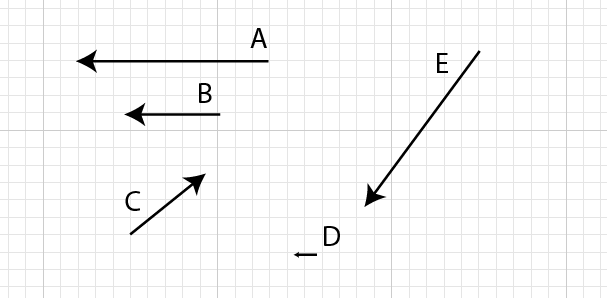
To change your vector, you accelerate in a particular direction. You add the vector produced by the thrust to your existing vector. Let’s add vectors E and D. D is conveniently 1G in the scale I’m suing for the diagrams, so it’s one turns worth of thrust for a Free Trader. Vector E will represent a velocity equal to 8 turns thrust at 1G. Adding vectors in a straight line is easy, your velocity vector just gets longer. Let’s change course.
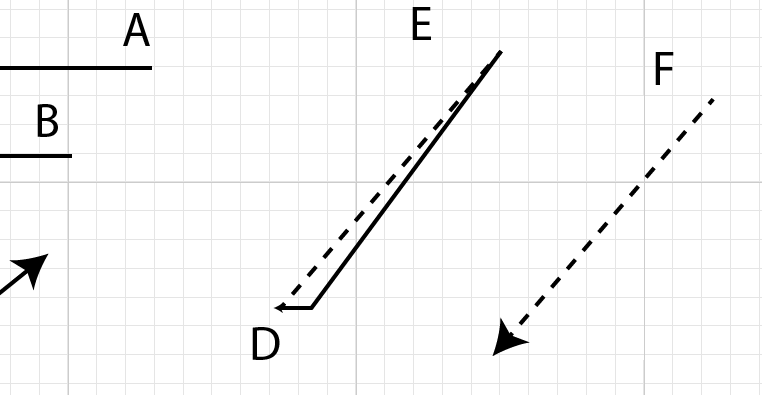
Vector F is the result of adding D and E together. The math behind vectors gets hairy in a mathematical sense, but graphically you literally lay them end to end and then draw a new vector from the start position and the end.
Let’s set the scene. A Free Trader has just jumped in-system, just outside the safe Jump radius of a Size 8 world. As we’ll see, we’re pretty far out already...
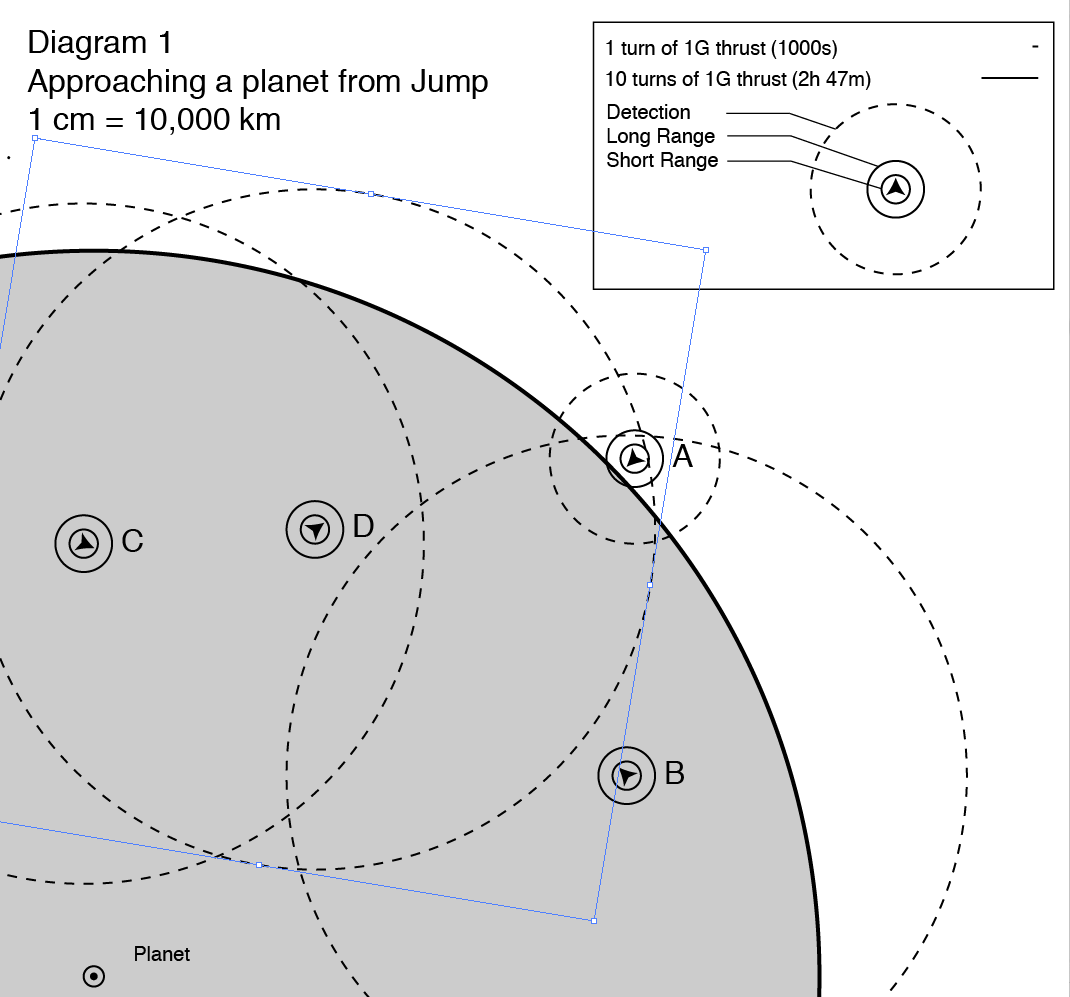
These rules have a “ground” scale of 1:100,000,000; a millimeter on the table is 100 kilometers. The safe Jump distance for a world the size of Earth (UPP code 8) is 20 times its diameter or about 256,000 kilometers. Or 2.56 meters on the floor. That’s also about the distance where you start taking range modifiers shooting lasers at people. For further example, that Size 8 planet will be 12.8 mm in diameter and geostationary orbit 357 mm from the surface. Earth’s moon is 3844 mm away, outside of Jump radius.
So to travel the 256 thousand kilometers from Earth in our Free Trader (max of 2G acceleration, or twice the pull of Earth’s gravity. to safe jump radius would take...
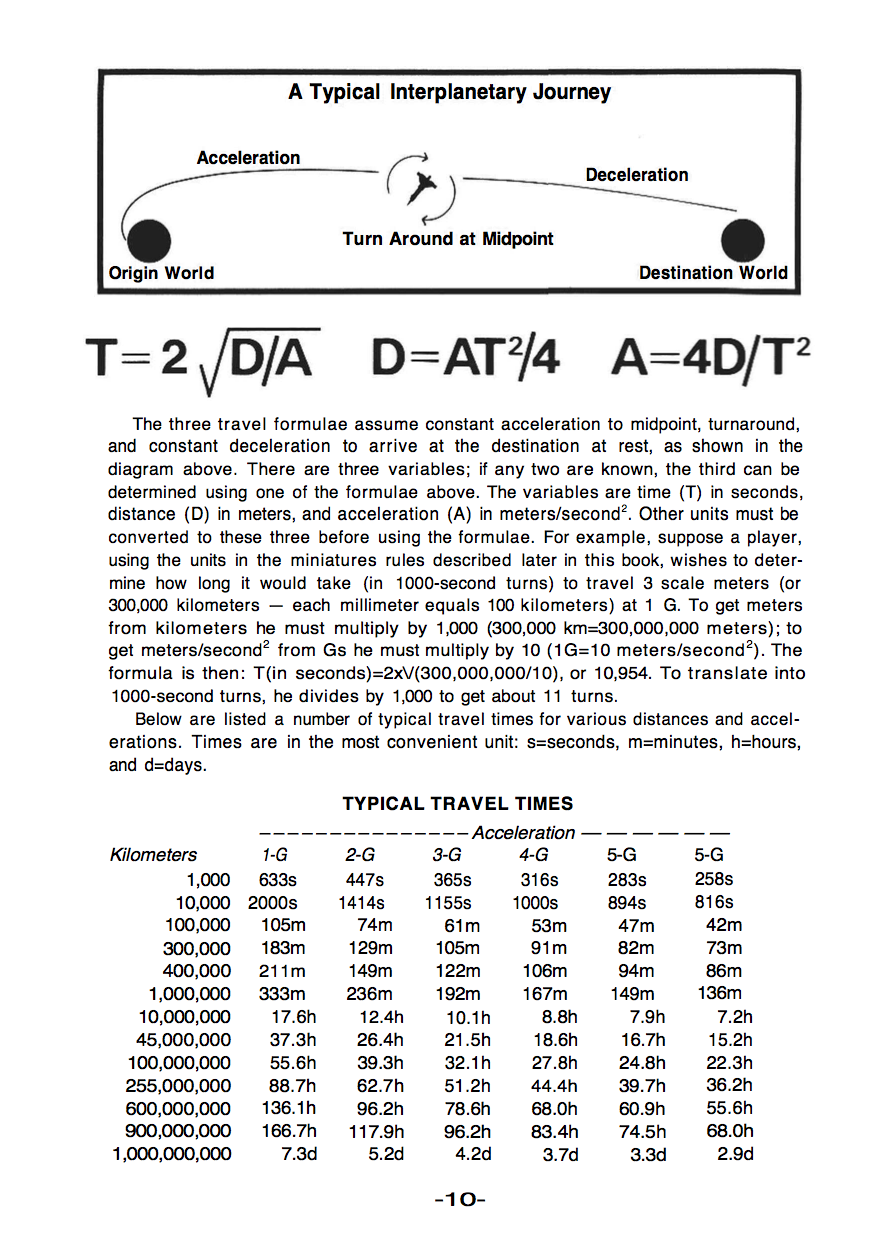
Yeeeeahhhhh. First off, the table assumes you want to end up at zero speed relative to your destination, so that’s out. We’re using this formula

Don’t forget that distance and acceleration both have to be in the same units; gravity is in meters so you convert 256,000km to 2.56x10e8 m. Call 1G acceleration (we’re in no hurry) 10 m/s and run it through the calculator app on your phone. 10120 seconds in round numbers, or 168 minutes. Yes, 1G of acceleration adds up real fast. If we decide we’re in a hurry and push it up to 2G (about as fast as non-military ships accelerate) we get there in 7155 seconds or 119 minutes. For grins lets see how fast we’re going when we pass Jump radius. Naturally, this formula isn’t given, in fact it’s the one the others are derived from: V=AT. At 1G we pass Radius going 101.2 km/s, and at 2G we’re at 143.1 km/s.
This may seem complicated, and it is, but guess what ? This actually is rocket science ! It also gets worse, some of you noticed that my travel times are assuming flat space. Take a look at this:
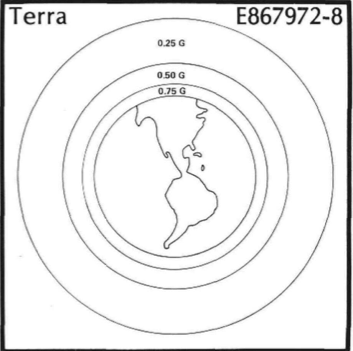
The planet should look familiar. And those concentric lines with gravitational forces ? That’s how strong the planet is going to bend your path. This system is actually accurate enough to fly a ship into orbit, or at least really close; Triplanetary did have a system that accurate and its from the same guys in the same period.
Here’s how you actually do it. In this version of Traveller you draw out your vectors and use simple vector addition for course changes just like in the vector example above. Another way to look at it is: if you don’t thrust, you keep moving like you did. If you do, you move where you were going to end up by as much as your thrust allows you.If you thrust 1 unit, you move where you were going to end up by 1 unit... and you get a new vector drawn from your origin to your new end point. Look at the diagram again.

That’s what we did here, we started at the beginning of vector E, applied thrust on vector D and now we’re moving F. If we don’t thrust next turn, we still move according to vector F. With a little practice you’ll get the visualization and it’ll work. Ken Burnside uses chocolates as motivational aids when teaching his 3D vector movement system, all you get here is a pretty diagram.
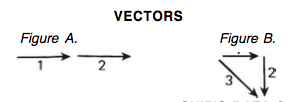
One last detail before you can start shooting at things. You have to be able to see your target. At this stage in Traveller’s evolution starship sensors don’t get a lot of detail. Civilian sensor arrays get a 1.5 million km detection radius, and military arrays get 6 million km. You don’t even pay for these during ship construction ! There’s another consideration in starship electronics: their computers. These get a fair amount of detail. Ships have a computer of a specific rating which governs their ability to run programs to actually do things. The specific programs would vanish after this edition in favor of a simple bonus based on relative computer ratings. Until then, we had an entire generation of Traveller campaigns stressing out about trying to get a copy of Multi-Target-2 or Auto/Evade or Predict-5 or Double Fire or...
Computers in Book 2 space combat are important. A Free Trader - the standard merchant ship and the one PCs might end up with - has a Model 1 computer, which can hold 4 programs and run 2 at once. One of those 2 slots for running programs goes to Maneuver, which allows the use of the ship’s maneuver drive. The other slot probably goes to Target, which lets you use your turrets. This is appallingly basic, a warship will also be running Predict programs for To Hit bonuses with laser turrets, ECM, Double Fire, evasion and a couple of other really handy programs a basic Free Trader just can’t run. The problem is, this is a bad 1970s take on computers. Adding capacity takes away space from other important things like fuel tankage, passenger capacity and so on. In other words, the classic “A ships computer weighs a ton” fallacy. The displacement ton in Traveller is a measure of volume, not mass. A seat, keyboard and screen for an operator takes up most of the 14 cubic meters in a Traveller ton all by itself.
Fucking shoot something already !
Ok, ok. The classic Free Trader is a 200 ton ship and can mount two turrets. Let’s put 3 beam lasers in one and a missile launcher and two sandcasters in the other. Then let’s say we’re paranoid and shooting at long range... Nope, we need an 8+ on 2d6 and get a -5 for long range. Let’s shoot up close... No modifiers (the pirate we’re shooting at isn’t running an Evasion program) so a straight 8+. For laughs we’ll say we’re shooting at the other ship you can get in chargen, the Type-S Scout. Rolling dice in IRC gets us two hits. There’s a hit location table ! We get one Hull and one Critical ! The Hull hit decompresses the enemy ship. Smart pirates are already in vacc suits, so nothing there. A 2 on the Critical table (it;’s only 1d6, don’t get excited) is Maneuver, that knocks the target’s maneuver drive down one letter grade (see ship construction in the next part), since nobody is building in redundant capacity the pirate Scout drops from 2G to 1G until repairs can be made. Congratulations, we pissed them off severely. Return fire will only be from a single turret, but a Scout has a better computer and so will be shooting with favorable DMs. We’re fucked, don’t do this in a Free Trader in actual play.
Other considerations . We also have rules for decompression, surviving it and how long it takes to put the air back in. Atmospheric braking is a possible maneuver crazy people can do near planets. And Abandon Ship has actual mechanics, as does fixing the damage you’re taking. The abandon ship section has one of my favorite throwaway lines in Classic Traveller: “A foamed atmospheric reentry ablation shield (part of the vacc suit kit) can protect the individual while entering atmosphere”. Yep, you suit up, grab a reentry kit and bail out. You then deploy a foam reentry shield, fire retro thrusters and ride the lightning down to the ground. This piece of equipment would later get a writeup and a cover in Megtraveller Journal 3. We’re only TL8 and people are riding balloons up fifty miles and jumping out; jumping out of a perfectly good space ship will be the next generation of Xtreme Games.
Wandering
Book 2 gets one more article. One on ship design, in which I will go through the process by way of example, plus whatever I decide I've left out, and then on to Book 3, Worlds and Adventure.
Part 6
Original SA post
Traveller pt. 6
Ships and Ship Design
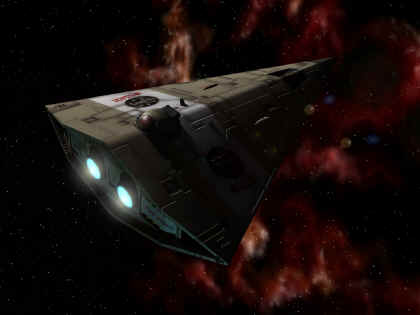
There’s absolutely no point in having a decent set of space combat rules in an RPG If you don’t get to design your own ships. Traveller has always had a decent set of design rules. In Book 2, they just supported the scale at which PC-owned ships lived. In Book 5 they expanded that to bigass space battleships. For right now we’re interested in the smaller ships PCs will interact with on a basis other than “an Imperial battle squadron is docking at the naval base insystem, for the love of god don’t deviate from your filed flight plan.”. Everything you’d want to know about Imperial BatRons, their compositions, deployment and doctrine would eventually end up in a supplement or two. For now, let’s look at the small fry in the universe.
The absolute smallest ship that can fit a Jump drive is 100 displacement tons, or 1400 cubic meters. Tons and money are the currency for fitting out a ship. Bigger ships take bigger drives to move at given accelerations or Jump ratings, in Book 5 you’d get the formula to calculate drive sizes and costs from total hull size and desired performance, in Book 2 we’re picking standard drives off a chart and plugging them in.
Every ship has “the usual” set of internal fittings like life support, air locks, a ships locker and so forth. We’re in the land of crunch, but not yet the land of Extreme Crunch so we don’t care about how many control stations we end up with on the bridge or the fine details on the sensor suite. In fact, the rules differentiate between military and civilian sensors and doesn't put either kind in the design rules. Megatraveller would fix this, oh boy would it ever.
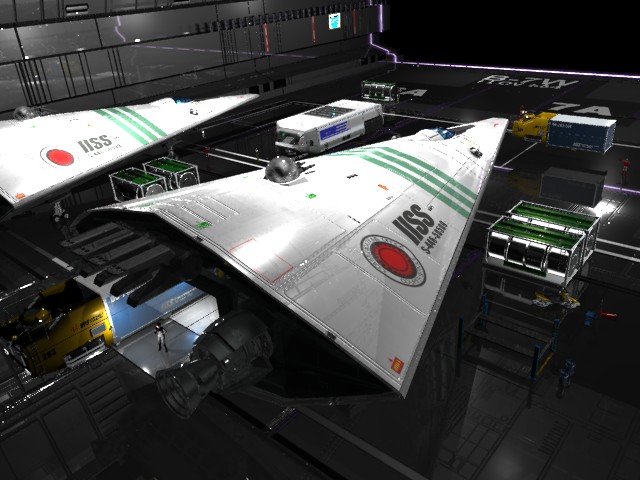
Ship’s Locker . Every ship has one for storing survival gear, tools, vacc suits, spare parts and useful bits of equipment as well as serving as the ship’s armory. This is the Traveller equivalent of writing “adventurer’s kit” on your character sheet and not worrying about having a 10 foot pole when you need one. This was also the name of the JTAS column where they introduced handy new bits of equipment.
That’s where the standard gear goes, what about the standard ships ?
There are several ! Two of them you can get in character creation,m if your character lives that long. Either the Scout Service dumps a superannuated Type-S Scout/Courier on a PC to save maintenance or you own a mortgage on a Free Trader. In Traveller, that term capitalized like that refers to a specific class of ship, or at least performance characteristics, i.e. a seriously cheap ship.
Classic Traveller ship designs
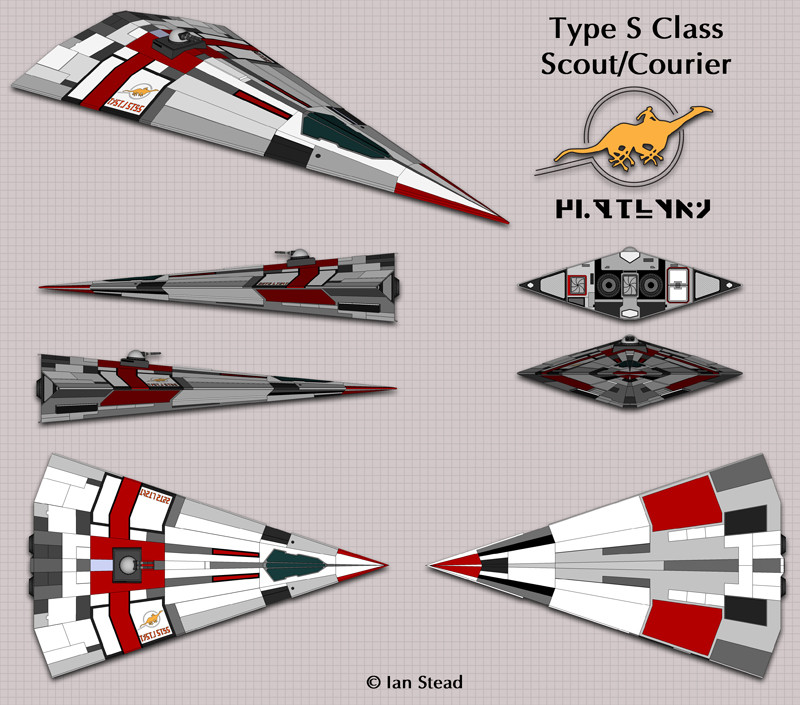
Type-S Scout/Courier. This wedge shaped little beauty is all over Imperial space and beyond, many of them in civilian hands. This proliferation, to use the technical term, is encouraged by the Imperium in the interests of saving a Cr or 2 on maintaining older ships, plus it’s always handy to be able to hide a covert ops team in plain sight. Deniability can be worth battle squadrons. If you roll one of these during character generation you get a 2G, Jump-2 ship with one turret, 4 staterooms, a tiny cargo hold and an air raft. Back in the 70s we decided on our own that “air raft” meant “flying pickup truck”; given that “pickup truck” and “gun rack” go together like “Traveller characters” and “obscene amounts of firepower” I think we were right. The deck plans in Supplement 7 proved us right anyway. You can’t make a lot of money in regular trade, but speculation on lightweight, valuable cargoes can make money, plus the fuel scoops mean you can get away with minimal operating costs. This makes it the ideal PC vessel, other than the limited anti-shipping firepower.
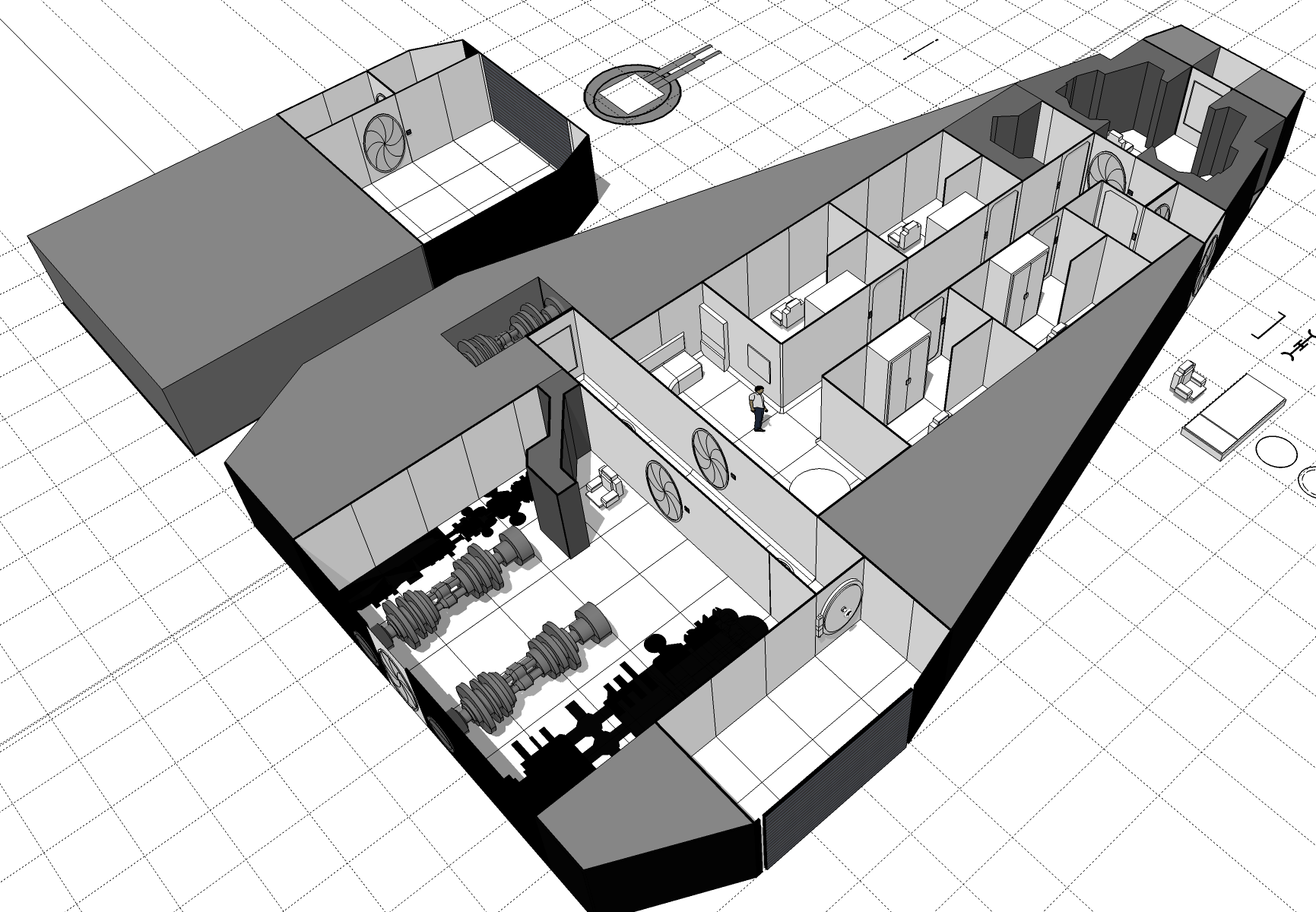
Type-A Free Trader. The Empress Marava-class merchant. 200 tons, 1G and Jump-1. No fuel scoops. You get 10 staterooms for crew and passengers, 20 cold sleep berths for those desperate to be elsewhere, fittings for 2 turrets but no actual guns, 82 tons of cargo and it’s streamlined so it can land anywhere. You have to make the payments on it, so it isn’t as good a PC vessel as the Scout, but it can get anywhere adventure is likely to happen and maybe make some money on the way back.
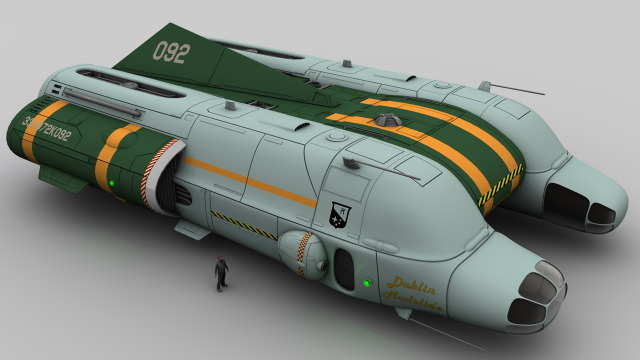
Type-R Subsidized Merchant. At 400 tons, 1G and Jump-1 and it’s no faster than the Type-A, but with 200 tons of cargo space it makes a lot more money per jump. It’s also required to run specific routes and set aside cargo space for carrying mail. That’s the “subsidized” portion. It’s easier to pay for, but sticking to the routes the government wants ships on won’t ever make you rich. With the same potential for armament as the smaller Free Trader she isn’t worth taking out of patrolled space anyway. It does have a ship’s boat (20-ton launch) by way of compensation and extra flexibility.
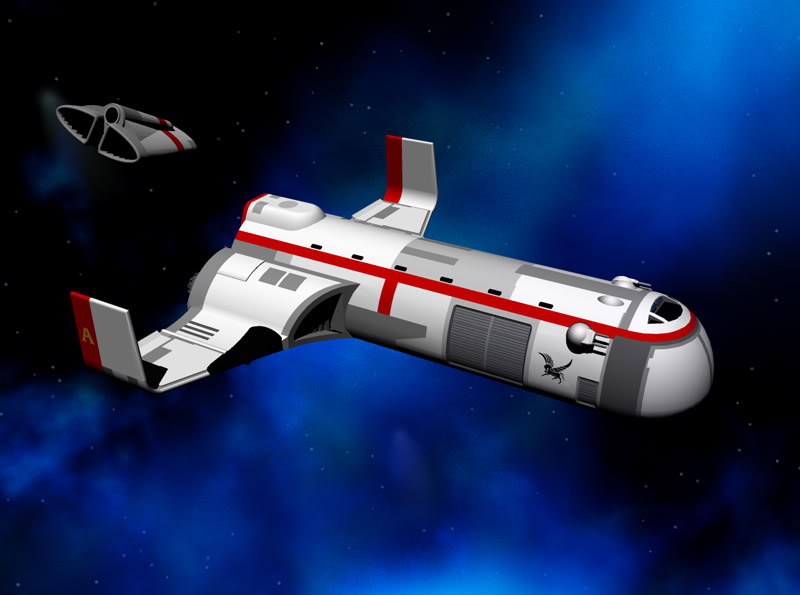
Book 2 also has design for a Yacht, a Mercenary Cruiser and a 400-ton Patrol Cruiser. The Mercenary Cruiser is suitable for a platoon-sized detachment of troops. Later JTAS articles and other publications would provide extensive detail about these ships, including deck plans.


For our design exercise I want a pirate corsair that can catch merchants and get away from patrols. The PC has Jump 3 and 4G acceleration, let’s try and match the acceleration, settle for Jump 2, and squeeze it into a 300 ton hull. That’s going to leave us light on firepower, but we aren’t interested in mixing it up with real warships.
Ship Design
Starting at the top of the design rules, we find that there’s a 1% surcharge to have the plans drawn up, extra for a rush job (why the fuck why you want a ship with a hurried design ?). We also find that the standard designs have a 10% mass production discount baked in to the listed price and that a 10-40% discount can be had on ships 10-40 years old.
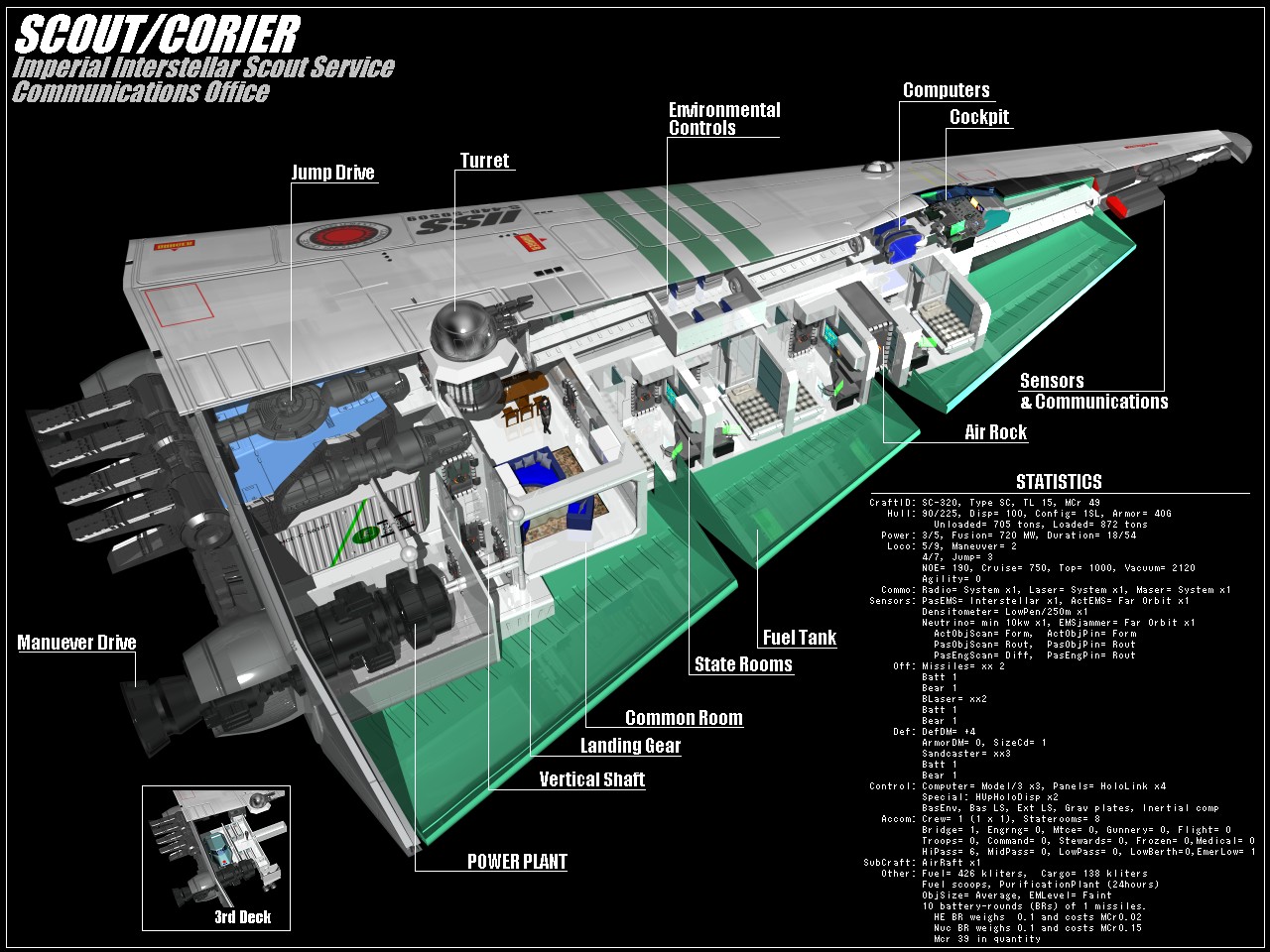
Engineering Comaprtment . We can pick a standard hull for a discount, but there isn’t one so we’re paying MCr30 for the hull (that’s MegaCredits). We need Jump and Maneuver drives, plus a power plant so we pick out a D and an H class drive respectively and a level H power plant. We also find that we’re getting screwed since a 300 ton hull rounds UP to 400 tons on the performance table. Later editions would fix this by pricing drives at a percentage of the ship’s tonnage multiplied by the performance of the drive, until then, odd tonnages get screwed. It’s particularly annoying because there are things in this edition that work as a percentage of hull volume.
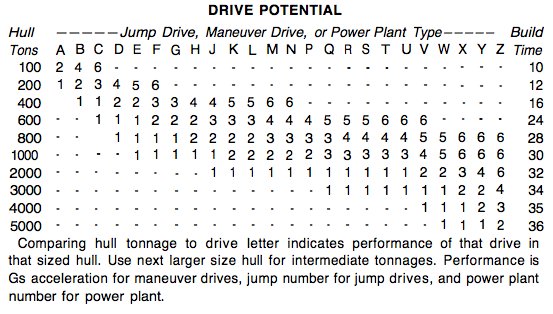
Main Compartment This is where everything else goes. We pay a small percentage for the bridge, stick in a Model 3 computer and fire add control for three turrets. We’ll account for the MCr3 worth of computer software bundled with the computer later.
Staterooms for the crew are next on the list, although you’ll need to skip ahead to calculate crew requirements. We need a pilot, two engineers, a medic, 3 gunners for the base ship. I also plan to fit a ship’s boat to carry boarding parties, so add another pilot. We’ll take 4 double-occupancy staterooms for the basic crew and a fifth for the captain/owner. These, surprisingly, cost 0.5MCr each, but that’s life support costs and so on. We’ll add more when we figure out how much space we have for cargo and troops.
Fuel . There’s a minimum just for operating fuel, 40 tons buys us 4 weeks. We need 60 tons for Jump 2 so basic operating fuel is 100 tons, or a full third of the ship’s volume just to jump a total of two parsecs and operate for 4 weeks.
At this point it’s obvious we can’t fit a 30-ton ship’s boat. We’ll recycle that crew slot as the navigator we actually needed anyway, and rely on docking operations to board our prey. We have 49 tons left to play with and we’re a pirate with no boarding parties. Let’s fit 5 more staterooms and 29 tons of cargo space. We’ll assume we’re clever and position it so we can both load cargo from another ship or park a vehicle in there and drop a ramp to use it planetside. In the interests of ransom, we’ll pay for full life support (not official, but a stateroom is 4 tons and 0.5 MCr, so 1 ton costs 0.125MCr) in the cargo hold for carrying prisoners.
This fine ship costs MCr194.925 without armament. I’m going to call a good armament for this 3 turrets each with 2 beam lasers for accuracy and a sandcaster for defense. This would add MCr 9.75 to the cost of the ship, plus a 1% architect’s fee. There’s plenty of room to mix up the armaments to suit taste later.
Oh yes, we also have MCr3 worth of computer programs, and a storage limit of 9 in a Model 3 computer. We must have: Maneuver, Jump-1, Jump-2, Target, Navigation, Generate for a total of MCr2.7 and 7 slots. Adding Library leaves us an empty slot and uses the last of the bundle allotment. Lastly, a writeup for the ship to show off the format they use to describe the 7 ships in the book. OD&D had more monsters than that... Oh, but let’s talk about wilderness encounters later.

Fast Corsair (type C): Using a 300-ton hull, the fast corsair is a short-ranged commerce raider frequently used by pirates. It mounts jump drive-D, maneuver drive-H and power plant-H, giving performance of jump-2 and 4-G acceleration. A 100-ton fuel tank provides fuel for the power plant and provides sufficient tankage for one jump-2. The ship’s avionics suite includes military-grade sensors, a Model-3 computer and fire control for it’s 3 turrets. A total of 10 staterooms provides quarters for the ship’s crew of 7 and ample room for boarding parties. No small craft are carried but ground vehicles carried in the 29-ton cargo hold can deploy through a boarding ramp. The cargo hold is fitted with full life support to allow for prisoner to be taken for labor or ransom. The ship is streamlined for planetary landings and fuel skimming from gas giants.
The fast corsair requires a pilot, navigator, medic, two engineers and 3 gunners and double-occupancy staterooms are provided. A stateroom is reserved for the captain/owner and five more provide space for a boarding party and prize crew. Life support in the hold will support 15 people on moderate comfort. The standard weapons fit for this class is three turrets with 2 beam lasers and a sandcaster each but almost anything could be found in practice.


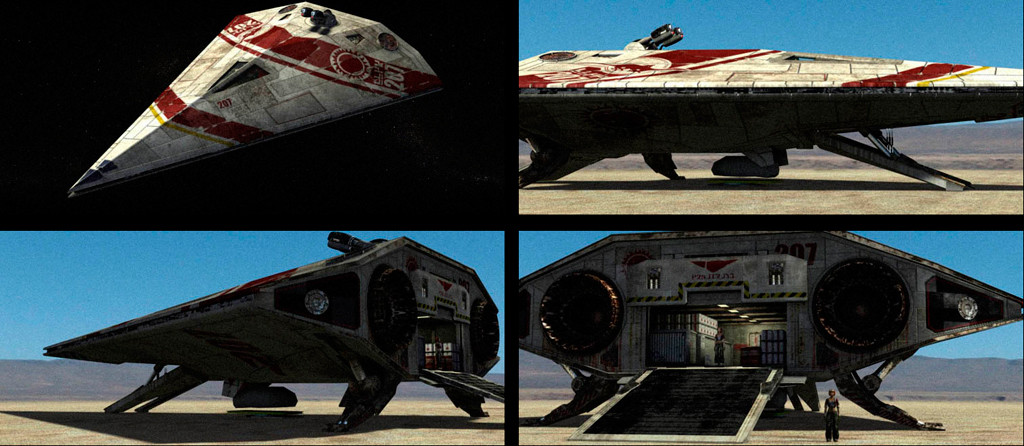
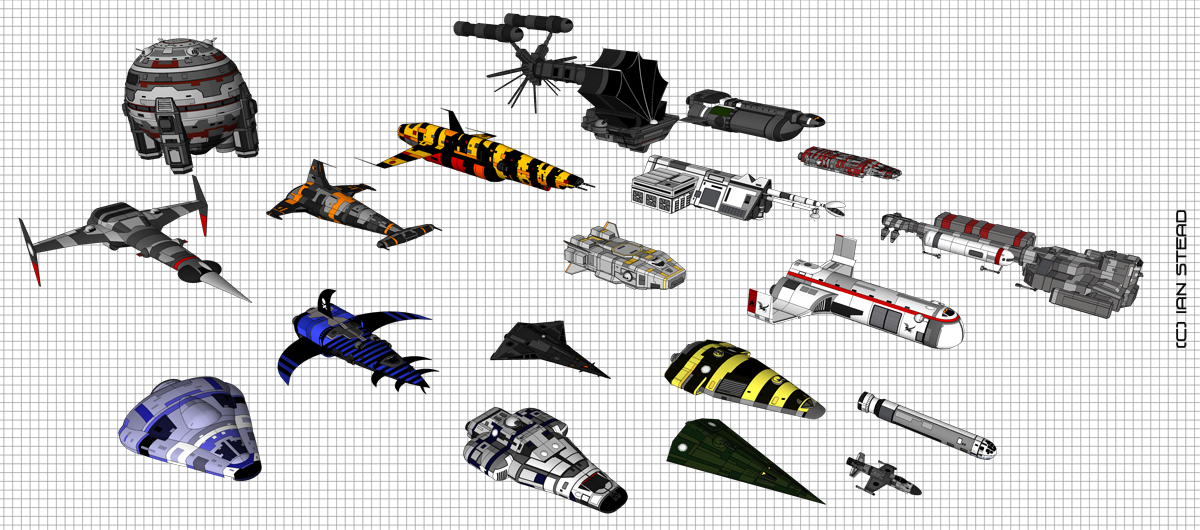




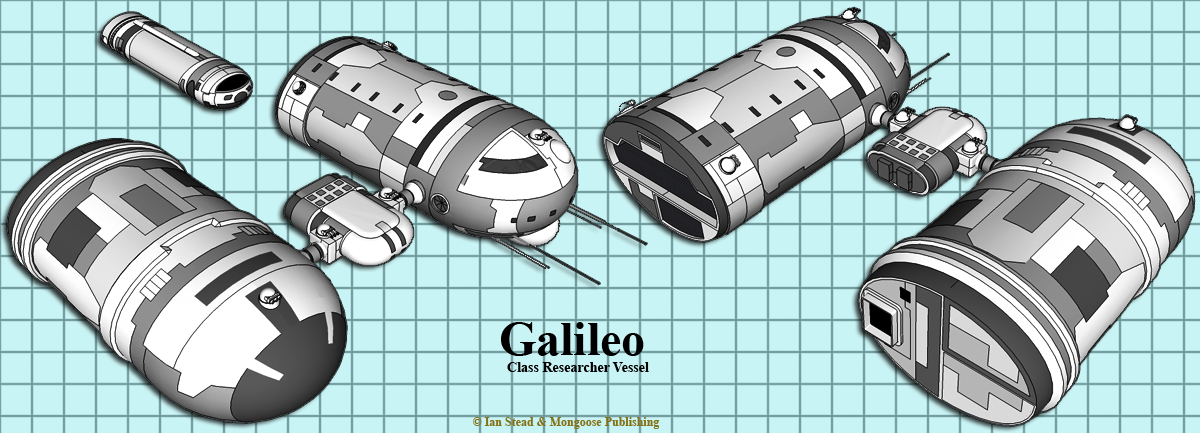


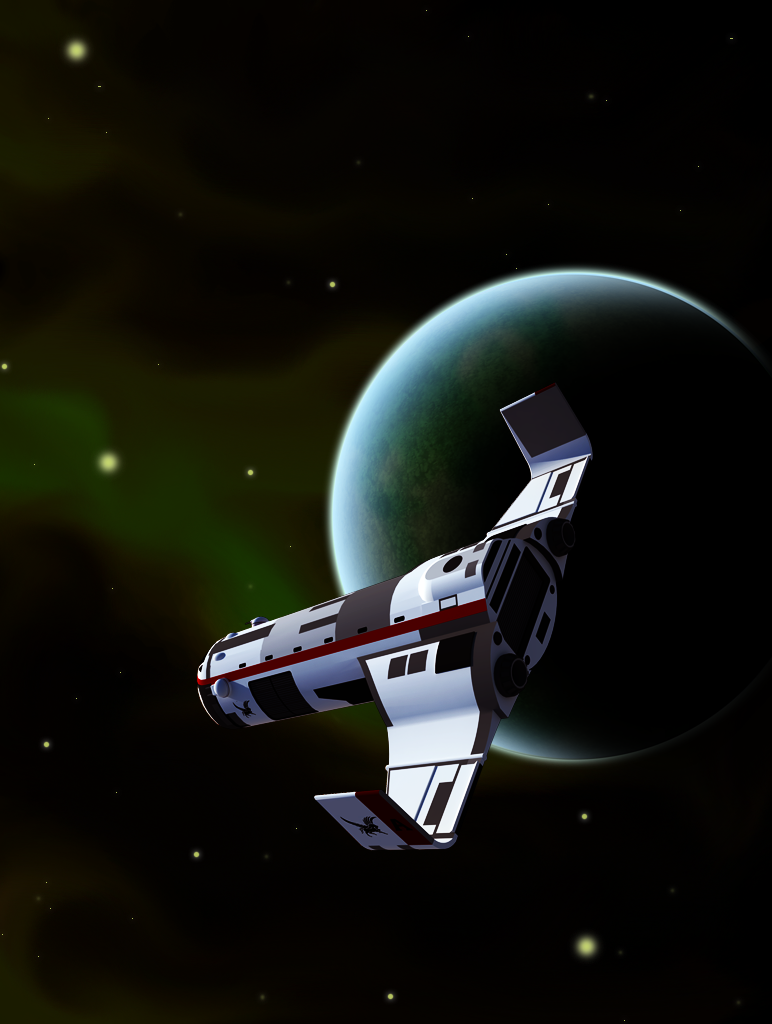
Part 7
Original SA post
Traveller pt. 7
Holy god, we’re only just starting Book 3 ?
Book 3 - Worlds and Adventures
Ok, we’ve rolled up our dudes, studied how to blow people up on foot and in space, checked out how to make a living with a starship (actually no, I should go over the interstellar economics stuff again), and had the “two ton computer” myth debunked (it’s 2 displacement tons of 14 m^3 each). We’ve got the rules down, now we need some place to go and some people to deal with.

Onward to adventure ! Book 3 is the DMG of the set, insofar as it has the worldbuilding stuff in it. All the rules for rolling up your own sectors of space are here, along with the people and animals that populate them. We’re going to make some Animal Encounter Tables ! We’re also going to get the psionics rules, which are not really OP, but do allow for teleportation... There’s also a handy assortment of futuristic equipment.
Let’s start with the gear, always a good place when trying to understand Traveller. There’s one immediate trend that leaps out at us. This is predominantly hostile environment survival gear. The vehicle list has a couple of mundane ground and skimmer cars, but then there’s two ATV’s (tracked and wheeled), a civvy model anti-grav IFV, and an assortment of mixed technology military vehicles as a representative sample of what PCs might run into on backwater, low-tech worlds. Plus the iconic air raft, the flying pickup truck. It the kind of equipment list that helps put you in the right frame of mind for classically Traveller kind of games: going to strange new worlds, meeting interesting new people, and obliterating them with advanced technology.

That brings right to the section on Encounters . Classic Traveller turns out to be really big on random encounters. A full-page table determines who is encountered, what they’re armed with and even if they have a vehicle with them. A reaction roll table is available to see how those strange new people react to our PCs.

Another very important class of NPC encounter is the patron. And yes, there’s a table to roll them up if necessary. The patron is the person or group who hires the PCs to undertake a mission. The basic guidelines for Patrons in book 3 would turn into the basic adventure structure of later supplemental material, notably a permanent series in the JTAS as well as Supplement 6 - 76 Patrons. The later material would structure a patron encounter description as their background, characteristics, motivations and then a 1d6 table of variations on the patron’s motivations and the exact details of how things get messy for the players. The rules in book 3 cover how the players go about finding a patron, detailing how long they have to work dive bars, hiring halls and the like before they run into someone with the money to pay for their unique skills. A table is provided to determine the patron’s background, but the details of the mission are left to the referee.
Encounters in space were covered in Book 2, here in Book 2 we deal with encounters on the ground or in a floating city, or a harvester platform deep underwater or...
The table for NPC encounters is blandly generic, a mix of peasants, thugs, merchants, noble, MPs, fugitives and so on. It isn’t explicitly stated, but it looks vaguely like an encounter table best suited for a starport, which is going to be the player’s main interface with any planet. The reaction table has both instant best friends and sudden violence with the usual 2d6 bell curve putting the average firmly in the middle. There’s a special rule that results of a natural 2 (violence) or a 12 (instant bros) are always the specified reaction (which is normal) and that you can’t get a 2 or a 12 with a DM (which is unusual). Since Traveller is murderhobos in space much of the time, this kind of reaction table fits with that style of game. There are a number of assumptions about style of play built into the rules, fortunately never being compulsory.

Once you get out and about on a planetary surface you run into fewer people and instead start worrying about dangerous and potentially tasty animals. “Procedure: The referee must create a series of unique encounter tables, one set for each world in the universe (not necessarily all are required before play begins).” Gee thanks, that tip will be a real timesaver. A set of tables for a world is one table for each terrain type on the world; there’s a list ranging from Clear, Prairie, Mountain through Beach, Marsh and Desert to Sargasso, Chasm and Crater. The referee is free to make tables that use one or two D6, the suggestions is one die for rarely used and two for areas that will need more variety. An example of each size of table is given. A note about Events are given, which is basically to put an entry on your tables and then do something appropriate for the adventure if you roll one.

Lookit all those animal types. The fun stuff is under Carnivore: Pouncer, Siren, Kill, Trapper... Now we’ll look at actually defining the animals roaming our planets. The suggested procedure is to take the table for each terrain type and roll up an animal. Take the category from the encounter table and roll on the Type table (modified by the terrain table) to get more detail about the critter. There’s also an Attributes table to see if you got a Swimmer or a Flyer and a Size table to roll up how big the thing is and what kind of natural weaponry it has, how tough its hide is and how much it takes to put one down. To finish up, there’s a table of characteristics to establish the rolls you need when you check to see if it attacks, flees or ignores the PCs until they do something loud. That’s three pages of tables, plus a page with an example encounter table, plus the actual rules all about populating encounter tables.

And there’s the Clear Terrain encounter table for a specific world. There’s literally no balance here at all, it’s gaming naturalism at its finest. You run into what you run into and you just hope a battered and bloody group doesn’t run into a shitload of carnivores.

In another example of rules and play style informing each other, we’ll eventually end up with a Safari ship adventure (Adventure 10) and a Hunter career path (Supplement 4). It’s a legitimate campaign type, and it looks like someone back in the early days of Traveller actually ran one.
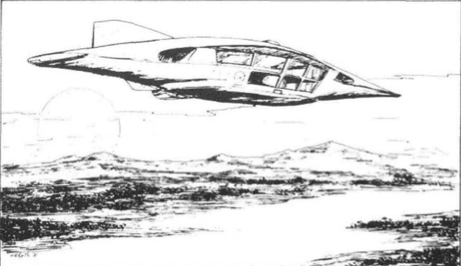
World Building

Finally, planets ! Technically, solar systems actually. Classic Traveller doesn’t care about anything but the primary world in a given solar system. The setting of your adventures isn’t a specific planet, it’s a whole subsector. Planets are just where some things happen, and all you really need to know about a world is a few very basic facts.
Planets, like characters, are defined by their physical and then their social characteristics. First up is the starport type, which is extremely important in trade, defines what sort of facilities are present and where you can get a ship built. Since many worlds will just be refueling stops and places where you might run into a pirate, starport type is the primary defining characteristic of any given world. During this portion you also check to see if the world has a Naval or Scout base present and if there are any gas giants for wilderness refuelling.

All of these characteristics are determined by rolling 2d6 and applying modifiers. The result is expressed like a character’s UPP, in fact UPP also means Universal Planetary Profile, with the same bits about using hexadecimal to represent the numbers to keep everything in convenient single digits.
After starport type, you roll planet size (which ties into combat in space and on the ground thanks to our old friend gravity), atmosphere type (can we breathe this shit) and how much of the surface is covered by water. Size is just the diameter of the planet in 1000s of miles, (a 0 means an asteroid belt), atmosphere has a table in which half of the entries require breathing support and hydrographics is the percentage of water coverage in 10% multiples of the number. The size rating is 2d6-2 and modifies the atmosphere roll (2d6-7+ size), the atmosphere rating in turn modifies the hydrographics roll. There are also special cases ! Asteroid belts (Size 0) have a 0 for atmosphere and hydrographics, any world with a 0 atmosphere rating has a 0 for hydrographics as well, etc, etc. At the high end of the atmosphere scale we get the fun stuff like
code:
0. Vacuum
....
A. Exotic
B. Corrosive
C. Insidous
That’s right, for all environments Population is rolled as 2d6-2. 0 is uninhabited, A is in the 10s of billions and for the numbers in between the population is 10^P where P is the Population digit. The population digit modifies Government (2d6-7+P) and Government modifies Law level (2d6-7+G). Government runs quite a gamut:
code:
0. No government
1. Company/Corporation
....
4. Representative Democracy
...
7. Balkanization. Many small governments, ideal for mercenary campaigns.
...
A. Charismatic Dictator
...
D. Religious Dictatorship
The last (rolled) characteristic of a world is it’s Tech Level. This represents the level of technology in general use on the world, which in turn determines what kind of firepower the locals have. It’s also hugely important in trade. The Imperium as a whole is TL15, modern-day Earth is on the cusp between 7 and 8, Jump drive is TL9. As a hugely important trait, there are a ton of modifiers to the TL roll ranging from population size, Starport type and a few bonus for hostile environments (spoiler: this effect would turn Virus into a much, much worse disaster than it would have been if garden worlds were more common). The modifiers are so extensive (the example below has a +9) that TL is rolled on 1d6. There are two pages giving examples of what exists at what TL.
After rolling 8 attributes, suitably modified, you have something like this
B-100-453-B N NonIndustrial, Desert, vacuum
We rolled a naval base, so this is whole system is pretty much the civilian infrastructure around a naval base. The place is a plain, barren rock. We check the trade classifications page and find out the few tens of thousands of inhabitants have to import an awful lot of stuff (Non-industrial, vacuum, desert) from somewhere.
That was one world. Page 13 of Book 13 is a subsector grid, an 8x10 hex grid. And under the rules as given, half of those hexes will have systems in them. Each hex is one parsec, 3.26 light years or Jump-1 range. To make your own subsector, roll for each hex to see if there’s a system there, then check starport types, bases and gas giants for each world; and then draw some communications routes. In the published setting, these routes are the Jump-4 Xboat courier network, if you’re making up your own universe you’ll probably still want to make up some routes anyway. Once you have the subsector populated, you then go through every single world (average, 40) and make 11 die rolls plus looking up the trade classifications. It’s no coincidence that one of my very first computer programs automated this process.
The end result is a region of space with about 40 worlds in it. Supplement 3 - The Spinward Marches provides data for the whole sector, 16 subsectors and hundreds of worlds, split between two huge and two major interstellar governments, plus a couple of independent backwaters. A whole sector is a vast playground. The publsihed setting... Well let’s just say it’s fucking huge, at least a dozen full sectors are detailed. Here’s the BIG map:
http://www.travellermap.com/
If you have a touch enabled device, use that, they did very nice work on the tablet version of the site.

See that sector highlighted in blue between the Zhodani Consulate and The Imperium ? That’s the Spinward Marches, all 16 subsectors. About a dozen other sectors are fully detailed in supplements, not counting the Atlas of the Imperium which was just maps and world statistics for the whole damn Imperium.

There’s a closer look at the Spinward Marches. Imperial borders in red, Zhodani in blue, Xboat routes are in green, worlds are the tiny white dots.
Zoom in again, subsector borders are in grey.

And again

And we have a good look at 4 subsectors along the Zhodani border (more about these guys later), with enough detail for names, starport types and a few symbols.
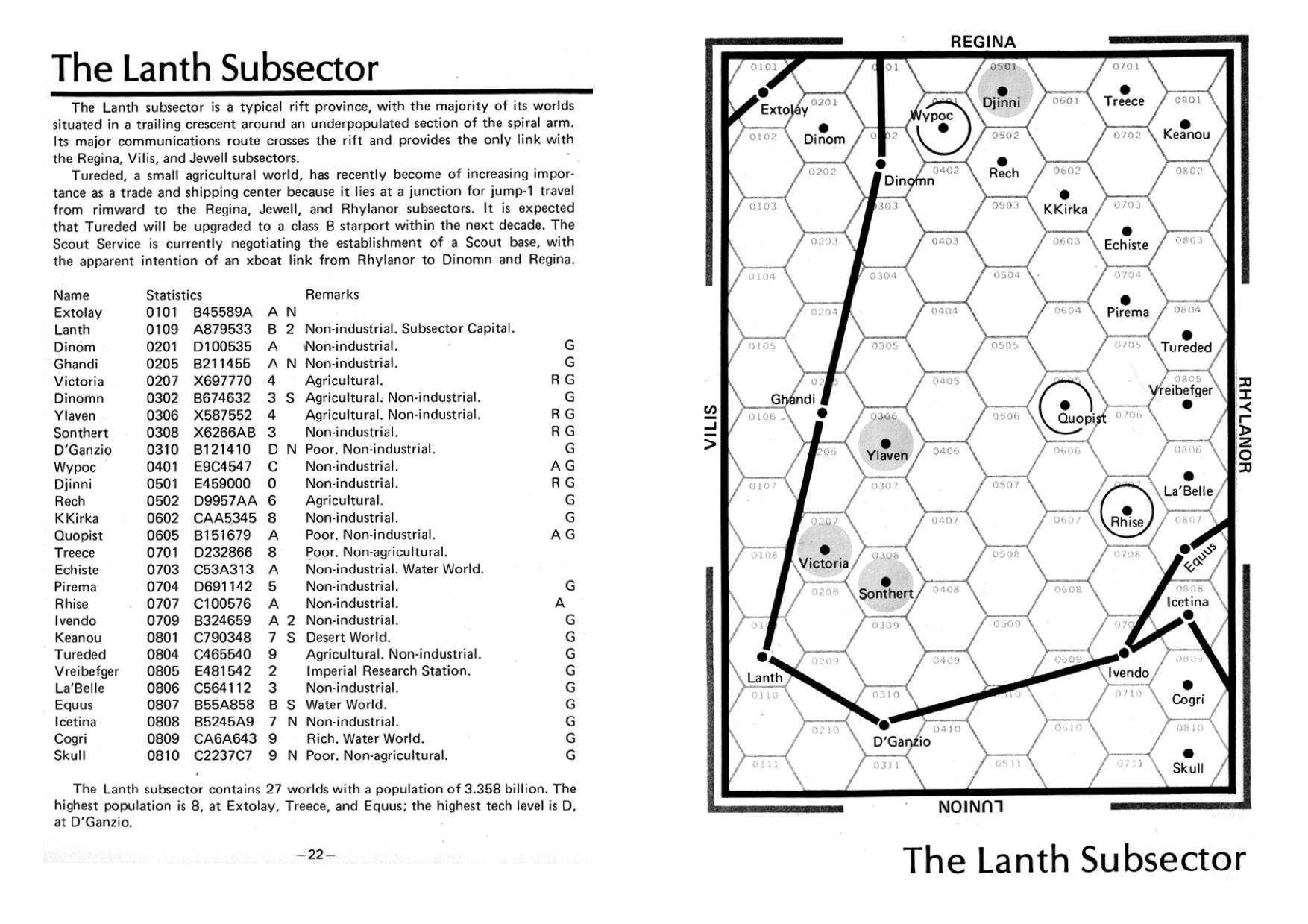
This is an excerpt from Supplement 3. Looking at the big map we see that the Xboat routes through this subsector are the only link to the sector capitol at Regina (Regina/Regina 0310 to give it’s location by System/Subsector hex number). Scanning the data for the 27 worlds we see a few agricultural worlds, only one Rich world and a lot of Non-industrial and Poor worlds. Looks like a good place to own a freighter, a Jump-1 Free Trader can reach 17 of 27 world. It can reach a lot more than that actually, one of the distinctive traits of the Spinward Marches is the existence of a long chain of worlds traversable at Jump-1. This is known as the Spinward Main and is where most merchant campaigns will take place. There’s a lot to be said against relying on tables too heavily as a GM, but random has its place in the wise GM’s toolkit. Finding perfect conditions for trading games in a randomly rolled sector is a pretty good result. Then they drew the borders by hand.
At this point in our survey of Classic Traveller we’re done with the rules for Classic Traveller. Let’s take another look at the big map as a palette cleanser ( http://www.travellermap.com/ ), next time it’s Trade and maybe a little on Psionics.
Lastly, each dot on this map is a world with a name, stats and probably a little bit of fluff.

Each. Dot.
Part 8
Original SA post
Traveller pt. 8
The Cool Stuff
Ok, the rules for Classic Traveller are sketchy but mostly complete. There are strong hints as to play style embedded in the rules, but little about the actual setting. The character generation system will produce a party of mostly ex-military types with their own starship. Encounters are tilted towards combat, even in space. A civilian ship can’t get a look at what might be lurking between its jump point and the planet. The equipment section is loaded with hostile environment survival gear. But just hints. After the boxed set with the first three books came out, GDW started publishing new rules, adventures and setting material. Let’s get an overview of the first few
1978 saw Book 4 - Mercenary come out with expanded character generation rules for Marine and Army characters. Supplement 1 - 1001 Characters had a ton of pregenerated characters, several long lists of stats for opponents encountered in great numbers (police, thugs, etc.) and nine characters from science fiction in Traveller terms (minus the names of course). Let’s see how many I can recognize/remember... One of Bester’s characters, Kimball Kinnison, one of Jack Vance’s characters from the Demon Princes series (it’s actually about someone hunting down five crimelords and not actual demons) , Earl Dumarest, Beowulf Shaeffer, Dominic Flandry, someone I don’t recognize, and Gully Foyle. I may have the two Bester characters mixed up. This is Traveller equivalent of Appendix N. Every single character mentioned here is a good inspiration for a Traveller game. Huh. I hadn’t read any Bester last time I looked at this section, he’s more of an inspiration for psionics in Traveller than EE Smith and Niven were. They still balk at giving PCs interplanetary teleportation. Their only other release this year is a big one: Maybe, the real space combat system. It has full rules for using any ship that comes out of the Book 2 design system, a less strictly realistic vector movement system on a hex grid, and combat rules that explain what the hell a sandcaster really does. In addition to a mere 3 Traveller releases GDW also had a healthy release schedule for its wargaming line.
Here’s what a Traveller supplement looks like. All the books have the same style in different colors.

Thank god the boardgames and magazine had cover art.

In 1979 things start to heat up for RPGs and the publication schedule picks up. Book 5 - High Guard comes out and needs a ton of errata for space combat, but Navy characters get both an expanded character generation system, a ship design system that lifts the limit from thousand tons to a million tons, and a combat system to use them. Oddly, the big ships wouldn’t get a proper wargame until Battle Rider in 1993 (and they wouldn’t get a playable game until the Full Thrust-based Power Projection in 2006). In 1979 the licensed material started to come out, Judges Guild being one of the very early adopters of course. Supplements 2, 3 and 4 came out all this year along with Adventure 1. The big news for players would be the launch of The Journal of the Traveller’s Aid Society as a quarterly magazine. This would be one of the most professional magazines of the era and one of the best house organs ever. I’ll do a Let’s Read on JTAS later, for now let’s look at the supplements that came out this year.
Supplement 2 - Animal Encounters aims to save the GM time by pregenerating a ton of encounter tables (see the previous part for how tedious that can get).
Supplement 3 - The Spinward Marches is the system data for the whole Spinward Marches sector. There is about a page worth of background, reprints of the descriptive portions of the world generation rules, just enough so you can read a UPP.
Supplement 4 - Citizens of the Imperium. This is another book full of pregenerated characters, but this time they’re from new career types presented in the book. We get: Pirates, Belters, Surface Navy, Diplomats, Doctors, Flyers, Barbarians, Bureaucrats, Rogues, Nobles and Hunters. Several of these careers can muster out owning a ship. The only downside is that these are all simple careers, not like the expanded ones given in Mercenary and High Guard.

Adventure 1 - Kinunir. Finally, a published adventure for the system. JTAS #1 would have a smaller adventure, but this is a big one. The meat of the booklet is statistics, deck plans, operational history and a sample crew for the 1200-ton Kinunir-class colonial battlecruiser. This is the first starship we’ll have deck plans for in Traveller, but far from the last. The rest of the book covers the Regina subsector to set the stage and then we get four related adventures. They’re all related by being set on a Kinunir-class ship. One has the party hired to get detailed specifications of the class, with a derelict ship available to be explored. A noble will hire the PCs as guides for a hunting expedition to a restricted world, the PCs get arrested by the crew from one cruiser and detained on another that was converted to a prison hulk. Then there’s a prison break mission set on the prison ship, setup so it can be an escape or a rescue. If you played the previous adventure, it’ll be an escape. One of the class was lost with all hands, finding it and figuring out what happened is the last adventure. That’s also the only adventure that doesn’t involve lawbreaking in some way.
To round up the early years of Traveller publication, Let’s Read the three issues of JTAS that came out in 1979.
JTAS #1

The editorial leads off the issue explaining what will be in the JTAS, especially the regular columns, makes a few remarks about Traveller calendars and how to write out dates or specify a world. They also announce that they licensed Judges Guild to produce Traveller material (set on the far side of the Imperium from the Spinward Marches) and that White Dwarf would be printing a Traveller mini campaign in issue #14. The regular material will be Amber Zone’s (short adventures) official rules modules, equipment in the Ship’s Locker and a few other things that will recur irregularly.
The first content is the Bestiary, which wasn’t mentioned and would be very regular. This issue has the Bush Runner, an obnoxious little (50kg) reptile and the Tree Kraken, which is an arboreal... octopus.

A Module on computer programming in Traveller looks suspiciously like the rules in Book 2 and probably just incorporates some errata. Their wargame Imperium gets some variant rules; it’s a classic game and worth playing. The Amber Zone “Rescue on Ruie” has the players hired to rescue a wealthy heir who got himself in trouble with some backwater local government. This scenario is only a page and a half of text, so much will be left to the referee. Some background details can be gleamed, including the name of a major shipping line. Then we get some new gear for the Ship’s Locker, including a gravitationally polarized explosive. The force expands perpendicularly to local gravity, very handy stuff. Credit is given to the author this is lifted from (James Blish). A selection of cold-weather gear appears along with rules for freezing to death.
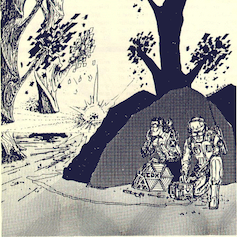
Then we get an adventure set on the weird alien ship we saw on the cover, the Annic Nova. This is a ship that is sort of a “local” legend on the star lanes, it’s been spotted before but it always jumped away before it could be investigated. Naturally the PCs get to be the first to board it. This being for an RPG in 1979, full rules are given for how to run the ship when the PCs inevitably decide to keep it for themselves. Annic Nova would get a graphical update and be published again as half of Double Adventure - 1 Annic Nova/Shadows next year. The scenario is a pretty good puzzle/exploration adventure set on a mysterious alien derelict. What movie about that came out in 1979 ? That wraps up issue 1.
JTAS #2

In the editorial Loren Wiseman takes exception to a review of Book 4 in The Dragon (June 79). This was apparently the thing to do in RPG publishing back in the dawn of time.This is mostly gearhead stuff, but it explains how conventional firearms work in a vacuum and why the wasn’t a laser pistol in Book 4. Then Loren demonstrates how to make stuff up for Traveller by making up... the laser pistol.
After all that fuss we get another new feature, one that would outlast JTAS itself: Traveller News Service. TNS is a page of in-universe new updates to keep the universe fresh. The first posts are about starship component licensing, which is boring, except when the new licensee makes things that explode unexpectedly, which has happened. This is a very quick sketch of the sort of megacorporation intrigue that can easily be used to drive a Traveller campaign.
Moving on to the Ship’s Locker we get rules for Airships, the TL7 lighter than air kind and diving equipment from TL3-7 (aka contemporary scuba stuff). Next up is the Serpent-class scout ship, which is a variant of the Type-S only in deck plans and particulars, it’s still 100 tons, Jump 2, 2Gs. This, I believe, predates any official publication on the ubiquitous Type-S other than its stats in Book 2. A Module on robots provides the first hints of transhumanism in Traveller by including all sorts of artificial beings including clones. Marc Miller doesn’t do computer stuff well, the Singularity to him is just a black hole. To aid the discussion, he gives us this handy graph.
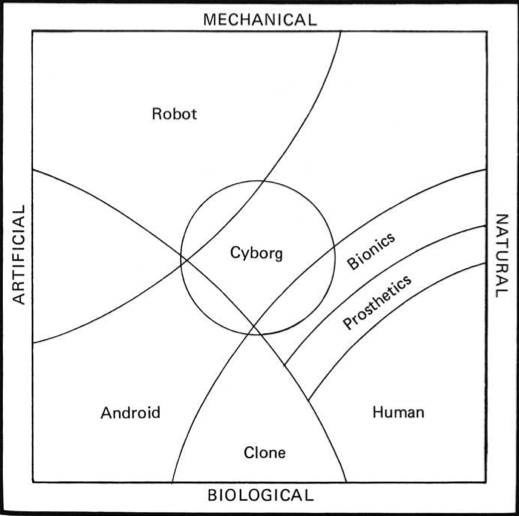
The new underwater rules will be handy for this issue’s Amber Zone, “The Ship in the Lake”. PCs get hired to retrieve some data from a sunken river boat and bring it back past the rebels. It's a nice tie-in with the Ship's Locker this issue and could be spun out into a serious trek through hostile territory. In two pages with art all you get is an idea, but they usually look like they'd be a good start for a GM.

The big highlight of this issue is the spotlight on the planet Victoria. For the first planet to get any real detail they chose a low population Red Zone with TL4 and a tainted atmosphere. Victoria is rated as X697770-4; size 6, thick, tainted atmosphere, 70% water, 10,000,000 population, no central government and really not much rule of law at all. The Scout Service had the world interdicted to preserve a metal-free society as a sociological laboratory. That explains the low TL and the X starport. The thick, tainted atmosphere is explained as having a heavy compound in it that is poisonous, human settlement is restricted to the the higher altitudes. Here's part of the map, they would soon formulate a standard template with a hex grid for planets. We'll see that in a few updates.

For local color we have dirigibles plying the trade routes that connect the habitable high mesas. Victoria occupies a strategic spot and should have a Xboat link to the sector capital but is instead interdicted. That’s the navy keeping a secure route to the capital away from spying eyes.

Victoria’s moon, Albert, has a described, but not mapped, ancient city (not capital letter Ancients) for the PCs to explore. That and a few scenario suggestions make up the adventure seeds section. The builders of the city are suggested to have seeded with
The alert reader will find a number of examples on worldbuilding and how to turn the UPP into an interesting, unique world. The key suggestion is to feel free to steal one from a book, they cite the obscure “Prisoner’s of the Sky” by CC MacApp as the inspiration from Victoria. However, little details like “what’s up with the air here” and clever explanations for why a world this close to a capitol has no starport and no technology and a sense of depth to your campaign and sets it apart.
This issue’s Bestiary is specific to Victoria and adds two more creatures in detail (a gazelle and a leech) and encounter tables for the low-lying chasms. These have more Event entries than the samples in the rulebooks, which is a good thing to encourage diversity.

The issue concludes with half a page from Marc Miller about dice he got at a convention and touched up with paint to make awesome. Really.

JTAS #3

JTAS is a house organ, so the editorial section in issue 3 is a preview of upcoming products, including the massive Azhanti High Lightning project (deck plans for a 60,000 ton ship and a simplified combat system since Snapshot wasn’t quite ready). This issue TNS updates us on the ship component problems from the last issue and a gag that the General Shipyard’s security division is considering a “take a number” system after 276 break-ins in the last six months (which is probably the number of people who played the first scenario in Adventure 1).
The very sparse robots material gets a second part. We say goodbye to any hints of transhumanism in Traveller and say hello to a design sequence for robots. This is very similar to starships, down to robot brains having specific capacities to run programs. We’ll get those next issue. Note: the following image was published AFTER Star Wars was released.

We get another set of variant rules for one of GDW’s SF wargames, this time Double Star, which is set in a binary star system, each of which has a colony on it. They build big fleets and fight each other. It has some very interesting ideas about training and marshaling a space fleet. I’m not aware that anyone has ever actually played this game.
Then we get the cover article, asteroid mining ! We get a page on the difficulties involved and then a mini-game on belt mining (that sounds dirty to modern ears, doesn’t it ?). You play on this flow chart:


Each box is a decision point, explained in more detail in 5 pages of rules for each box. The procedure is you show up with a ship, get a license, and go prospecting. Maybe you’ll hit it rich and maybe you’ll go broke paying a rescue fee. I really, really wish this sort of thing had caught on, although some hints of it may survive in Diaspora. It’s a diverting little game in its own right.
In the Ship’s Locker this issue is Advanced Power Battle Armor, or what every referee needs after seeing what PCs with their own power armor and energy weapons can do. It’s restricted to military only to help keep it out of PC hands. The damn thing has a flamethrower, which is also its only weakness. Taking out a fuel tank on one of those would be bad, and Really Bad shipboard. A second entry details the standard ATV, a massive, long range exploration vehicle that rides on 8 fat tire over any terrain. It looks like a cross between ARK ONE and the Mako although it is unarmed. In an Amber Zone called “Planetoid P-4638” the players have to black bag a manufacturing facility for data worth billions to the corp hiring them and a cool Cr1,000,000 to the PCs. Again, no map is given in an Amber Zone, just a little detail on the opposition and some suggestions on how to mix it up. Lastly, The Bestiary has the cute little Beaker Monkey, which is a good pet, and a fantastic pet for a psionic PC.

The Sea Bear on the other hand is a dangerous aquatic predator that can be found on several worlds around the Chronor subsector. Man, 3rd Imperium terraformers will import anything to fill an ecological niche. Fortunately, it isn’t as big as the name implies, adults are only around 25 kg. Unfortunately, they fill the same niche as seals and so they come in large numbers around a rookery.

They end with a handy checklist/subtle ad for Book 4 - Mercenary character creation. I’ll get into the new rules next time.